Importance of Study Skills
VerifiedAdded on 2023/06/18
|27
|5600
|262
AI Summary
The aim of this essay is to outline the importance of study skills. According to Cottrell (2019), a skill is a learned ability achieved through luck or chance. Skills can be fine-tuned through practice, feedback and reflection, just as athletes improve their performance by everyday practice. In The Study handbook (Cottrell 2019), study skills are defined as abilities, habits, understandings and attitudes that enable achievement in study. These can be categorized in four inter-related areas: self, academic, people and task.
Contribute Materials
Your contribution can guide someone’s learning journey. Share your
documents today.
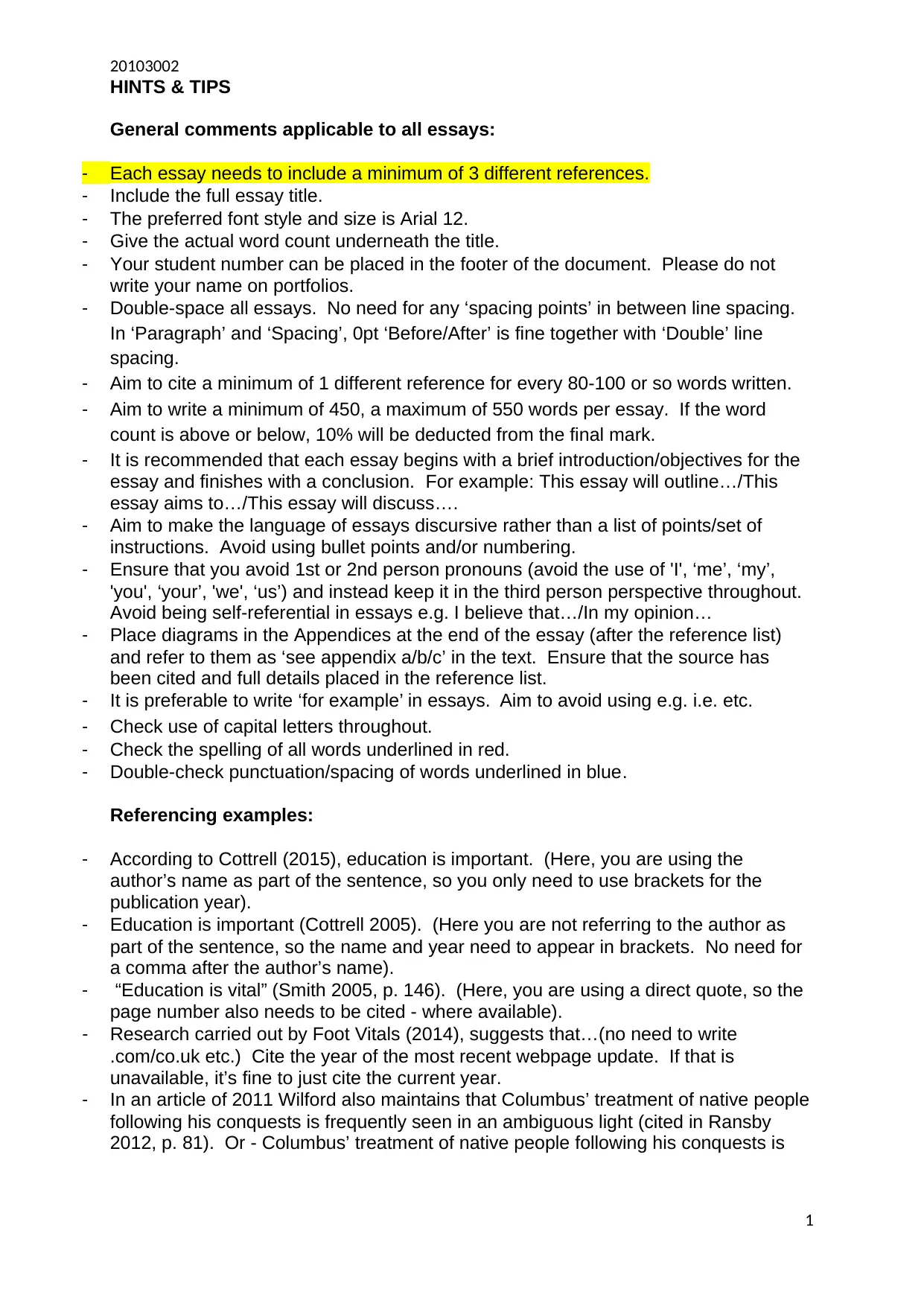
20103002
HINTS & TIPS
General comments applicable to all essays:
- Each essay needs to include a minimum of 3 different references.
- Include the full essay title.
- The preferred font style and size is Arial 12.
- Give the actual word count underneath the title.
- Your student number can be placed in the footer of the document. Please do not
write your name on portfolios.
- Double-space all essays. No need for any ‘spacing points’ in between line spacing.
In ‘Paragraph’ and ‘Spacing’, 0pt ‘Before/After’ is fine together with ‘Double’ line
spacing.
- Aim to cite a minimum of 1 different reference for every 80-100 or so words written.
- Aim to write a minimum of 450, a maximum of 550 words per essay. If the word
count is above or below, 10% will be deducted from the final mark.
- It is recommended that each essay begins with a brief introduction/objectives for the
essay and finishes with a conclusion. For example: This essay will outline…/This
essay aims to…/This essay will discuss….
- Aim to make the language of essays discursive rather than a list of points/set of
instructions. Avoid using bullet points and/or numbering.
- Ensure that you avoid 1st or 2nd person pronouns (avoid the use of 'I', ‘me’, ‘my’,
'you', ‘your’, 'we', ‘us’) and instead keep it in the third person perspective throughout.
Avoid being self-referential in essays e.g. I believe that…/In my opinion…
- Place diagrams in the Appendices at the end of the essay (after the reference list)
and refer to them as ‘see appendix a/b/c’ in the text. Ensure that the source has
been cited and full details placed in the reference list.
- It is preferable to write ‘for example’ in essays. Aim to avoid using e.g. i.e. etc.
- Check use of capital letters throughout.
- Check the spelling of all words underlined in red.
- Double-check punctuation/spacing of words underlined in blue.
Referencing examples:
- According to Cottrell (2015), education is important. (Here, you are using the
author’s name as part of the sentence, so you only need to use brackets for the
publication year).
- Education is important (Cottrell 2005). (Here you are not referring to the author as
part of the sentence, so the name and year need to appear in brackets. No need for
a comma after the author’s name).
- “Education is vital” (Smith 2005, p. 146). (Here, you are using a direct quote, so the
page number also needs to be cited - where available).
- Research carried out by Foot Vitals (2014), suggests that…(no need to write
.com/co.uk etc.) Cite the year of the most recent webpage update. If that is
unavailable, it’s fine to just cite the current year.
- In an article of 2011 Wilford also maintains that Columbus’ treatment of native people
following his conquests is frequently seen in an ambiguous light (cited in Ransby
2012, p. 81). Or - Columbus’ treatment of native people following his conquests is
1
HINTS & TIPS
General comments applicable to all essays:
- Each essay needs to include a minimum of 3 different references.
- Include the full essay title.
- The preferred font style and size is Arial 12.
- Give the actual word count underneath the title.
- Your student number can be placed in the footer of the document. Please do not
write your name on portfolios.
- Double-space all essays. No need for any ‘spacing points’ in between line spacing.
In ‘Paragraph’ and ‘Spacing’, 0pt ‘Before/After’ is fine together with ‘Double’ line
spacing.
- Aim to cite a minimum of 1 different reference for every 80-100 or so words written.
- Aim to write a minimum of 450, a maximum of 550 words per essay. If the word
count is above or below, 10% will be deducted from the final mark.
- It is recommended that each essay begins with a brief introduction/objectives for the
essay and finishes with a conclusion. For example: This essay will outline…/This
essay aims to…/This essay will discuss….
- Aim to make the language of essays discursive rather than a list of points/set of
instructions. Avoid using bullet points and/or numbering.
- Ensure that you avoid 1st or 2nd person pronouns (avoid the use of 'I', ‘me’, ‘my’,
'you', ‘your’, 'we', ‘us’) and instead keep it in the third person perspective throughout.
Avoid being self-referential in essays e.g. I believe that…/In my opinion…
- Place diagrams in the Appendices at the end of the essay (after the reference list)
and refer to them as ‘see appendix a/b/c’ in the text. Ensure that the source has
been cited and full details placed in the reference list.
- It is preferable to write ‘for example’ in essays. Aim to avoid using e.g. i.e. etc.
- Check use of capital letters throughout.
- Check the spelling of all words underlined in red.
- Double-check punctuation/spacing of words underlined in blue.
Referencing examples:
- According to Cottrell (2015), education is important. (Here, you are using the
author’s name as part of the sentence, so you only need to use brackets for the
publication year).
- Education is important (Cottrell 2005). (Here you are not referring to the author as
part of the sentence, so the name and year need to appear in brackets. No need for
a comma after the author’s name).
- “Education is vital” (Smith 2005, p. 146). (Here, you are using a direct quote, so the
page number also needs to be cited - where available).
- Research carried out by Foot Vitals (2014), suggests that…(no need to write
.com/co.uk etc.) Cite the year of the most recent webpage update. If that is
unavailable, it’s fine to just cite the current year.
- In an article of 2011 Wilford also maintains that Columbus’ treatment of native people
following his conquests is frequently seen in an ambiguous light (cited in Ransby
2012, p. 81). Or - Columbus’ treatment of native people following his conquests is
1
Secure Best Marks with AI Grader
Need help grading? Try our AI Grader for instant feedback on your assignments.
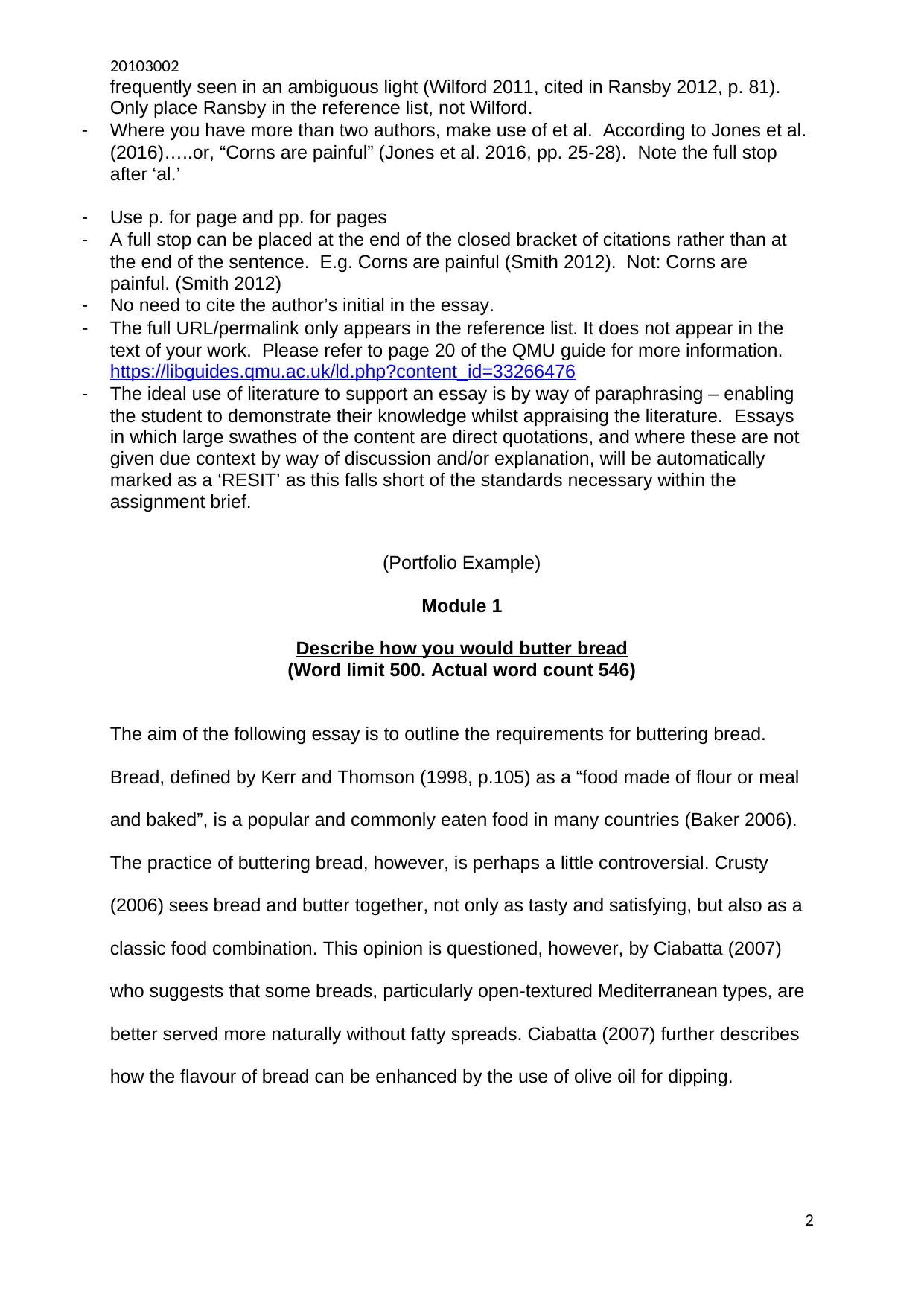
20103002
frequently seen in an ambiguous light (Wilford 2011, cited in Ransby 2012, p. 81).
Only place Ransby in the reference list, not Wilford.
- Where you have more than two authors, make use of et al. According to Jones et al.
(2016)…..or, “Corns are painful” (Jones et al. 2016, pp. 25-28). Note the full stop
after ‘al.’
- Use p. for page and pp. for pages
- A full stop can be placed at the end of the closed bracket of citations rather than at
the end of the sentence. E.g. Corns are painful (Smith 2012). Not: Corns are
painful. (Smith 2012)
- No need to cite the author’s initial in the essay.
- The full URL/permalink only appears in the reference list. It does not appear in the
text of your work. Please refer to page 20 of the QMU guide for more information.
https://libguides.qmu.ac.uk/ld.php?content_id=33266476
- The ideal use of literature to support an essay is by way of paraphrasing – enabling
the student to demonstrate their knowledge whilst appraising the literature. Essays
in which large swathes of the content are direct quotations, and where these are not
given due context by way of discussion and/or explanation, will be automatically
marked as a ‘RESIT’ as this falls short of the standards necessary within the
assignment brief.
(Portfolio Example)
Module 1
Describe how you would butter bread
(Word limit 500. Actual word count 546)
The aim of the following essay is to outline the requirements for buttering bread.
Bread, defined by Kerr and Thomson (1998, p.105) as a “food made of flour or meal
and baked”, is a popular and commonly eaten food in many countries (Baker 2006).
The practice of buttering bread, however, is perhaps a little controversial. Crusty
(2006) sees bread and butter together, not only as tasty and satisfying, but also as a
classic food combination. This opinion is questioned, however, by Ciabatta (2007)
who suggests that some breads, particularly open-textured Mediterranean types, are
better served more naturally without fatty spreads. Ciabatta (2007) further describes
how the flavour of bread can be enhanced by the use of olive oil for dipping.
2
frequently seen in an ambiguous light (Wilford 2011, cited in Ransby 2012, p. 81).
Only place Ransby in the reference list, not Wilford.
- Where you have more than two authors, make use of et al. According to Jones et al.
(2016)…..or, “Corns are painful” (Jones et al. 2016, pp. 25-28). Note the full stop
after ‘al.’
- Use p. for page and pp. for pages
- A full stop can be placed at the end of the closed bracket of citations rather than at
the end of the sentence. E.g. Corns are painful (Smith 2012). Not: Corns are
painful. (Smith 2012)
- No need to cite the author’s initial in the essay.
- The full URL/permalink only appears in the reference list. It does not appear in the
text of your work. Please refer to page 20 of the QMU guide for more information.
https://libguides.qmu.ac.uk/ld.php?content_id=33266476
- The ideal use of literature to support an essay is by way of paraphrasing – enabling
the student to demonstrate their knowledge whilst appraising the literature. Essays
in which large swathes of the content are direct quotations, and where these are not
given due context by way of discussion and/or explanation, will be automatically
marked as a ‘RESIT’ as this falls short of the standards necessary within the
assignment brief.
(Portfolio Example)
Module 1
Describe how you would butter bread
(Word limit 500. Actual word count 546)
The aim of the following essay is to outline the requirements for buttering bread.
Bread, defined by Kerr and Thomson (1998, p.105) as a “food made of flour or meal
and baked”, is a popular and commonly eaten food in many countries (Baker 2006).
The practice of buttering bread, however, is perhaps a little controversial. Crusty
(2006) sees bread and butter together, not only as tasty and satisfying, but also as a
classic food combination. This opinion is questioned, however, by Ciabatta (2007)
who suggests that some breads, particularly open-textured Mediterranean types, are
better served more naturally without fatty spreads. Ciabatta (2007) further describes
how the flavour of bread can be enhanced by the use of olive oil for dipping.
2

20103002
Reference Lists
The SMAE recommended guidance to Harvard referencing is from the QMU, SMAEs
credit rating partner. Please refer to the ‘Write & cite 2020’ guide below for
information on referencing and reference lists:
https://libguides.qmu.ac.uk/ld.php?content_id=33266476
(Note use of italics and punctuation. Place sources in alphabetical order in the
reference list using the first letter of the surname/first letter of the
organisation/website name).
BBC, 2020. Bianca Williams: Athlete accuses police of racial profiling after vehicle
search [Online]. [Accessed 6 July 2020]. Available from:
https://www.bbc.co.uk/sport/athletics/53301318
BONEN, A. and SHAW, S.M., 1996. Recreational exercise participation and aerobic
fitness in men and women: analysis of data from a national survey. Journal of Sports
Science. August, vol. 13, no. 4, pp. 297-303.
BURNS, T., 2004. Teaching, learning and study skills: a guide for tutors. London:
Sage.
COTTER, D., MANNING, R.J., BLOW, K.J., ELLIS, A.D., KELLY, A.E. and NESSET,
D., 1999. Non-linear optics for high-speed digital information processing. Science
[Online]. November, vol. 286, no. 5444, pp. 1523-1528 [Accessed 21 August 2020].
Available from: http://www.sciencemag.org
COTTRELL, S., 2019. The Study Skills Handbook. 5th ed. London: Red Globe Press,
p. 63.
DR FOOT, 2020. Antalgic Gait [Online]. [Accessed 22 March 2020]. Available from:
https://www.drfoot.co.uk/antalgic-gait.htm
MANDELSTAM, M., 2009. Community care practice and the law [Online]. 4th ed.
London: Jessica Kingsley Publishers [Accessed 26 June 2020]. Available from:
http://site.ebrary.com/lib/qmuc/Doc?id=10264096
Merriam-Webster.com dictionary, 2020 [Online]. [Accessed 23 July 2020]. Available
from: https://www.merriam-webster.com/dictionary/intersectionality
NICE, 2020. Tinnitus: assessment and management [NG155]. [Online]. [Accessed 20
September 2020]. Available from: https://www.nice.org.uk/guidance/ng155
SPRINGETT, K. and JOHNSON, M., 2010. The Skin and Nails in Podiatry. In: P.
FROWEN, M. O’DONNELL, D. LORIMER, G. BURROW, eds. Neale’s Disorders of
the Foot. 8th ed. London: Churchill Livingstone Elsevier, p. 21.
THE SMAE INSTITUTE, 2020. Credit Rated Foot Health Course. Module 6, The
Skin. Maidenhead: The SMAE Institute.
3
Reference Lists
The SMAE recommended guidance to Harvard referencing is from the QMU, SMAEs
credit rating partner. Please refer to the ‘Write & cite 2020’ guide below for
information on referencing and reference lists:
https://libguides.qmu.ac.uk/ld.php?content_id=33266476
(Note use of italics and punctuation. Place sources in alphabetical order in the
reference list using the first letter of the surname/first letter of the
organisation/website name).
BBC, 2020. Bianca Williams: Athlete accuses police of racial profiling after vehicle
search [Online]. [Accessed 6 July 2020]. Available from:
https://www.bbc.co.uk/sport/athletics/53301318
BONEN, A. and SHAW, S.M., 1996. Recreational exercise participation and aerobic
fitness in men and women: analysis of data from a national survey. Journal of Sports
Science. August, vol. 13, no. 4, pp. 297-303.
BURNS, T., 2004. Teaching, learning and study skills: a guide for tutors. London:
Sage.
COTTER, D., MANNING, R.J., BLOW, K.J., ELLIS, A.D., KELLY, A.E. and NESSET,
D., 1999. Non-linear optics for high-speed digital information processing. Science
[Online]. November, vol. 286, no. 5444, pp. 1523-1528 [Accessed 21 August 2020].
Available from: http://www.sciencemag.org
COTTRELL, S., 2019. The Study Skills Handbook. 5th ed. London: Red Globe Press,
p. 63.
DR FOOT, 2020. Antalgic Gait [Online]. [Accessed 22 March 2020]. Available from:
https://www.drfoot.co.uk/antalgic-gait.htm
MANDELSTAM, M., 2009. Community care practice and the law [Online]. 4th ed.
London: Jessica Kingsley Publishers [Accessed 26 June 2020]. Available from:
http://site.ebrary.com/lib/qmuc/Doc?id=10264096
Merriam-Webster.com dictionary, 2020 [Online]. [Accessed 23 July 2020]. Available
from: https://www.merriam-webster.com/dictionary/intersectionality
NICE, 2020. Tinnitus: assessment and management [NG155]. [Online]. [Accessed 20
September 2020]. Available from: https://www.nice.org.uk/guidance/ng155
SPRINGETT, K. and JOHNSON, M., 2010. The Skin and Nails in Podiatry. In: P.
FROWEN, M. O’DONNELL, D. LORIMER, G. BURROW, eds. Neale’s Disorders of
the Foot. 8th ed. London: Churchill Livingstone Elsevier, p. 21.
THE SMAE INSTITUTE, 2020. Credit Rated Foot Health Course. Module 6, The
Skin. Maidenhead: The SMAE Institute.
3
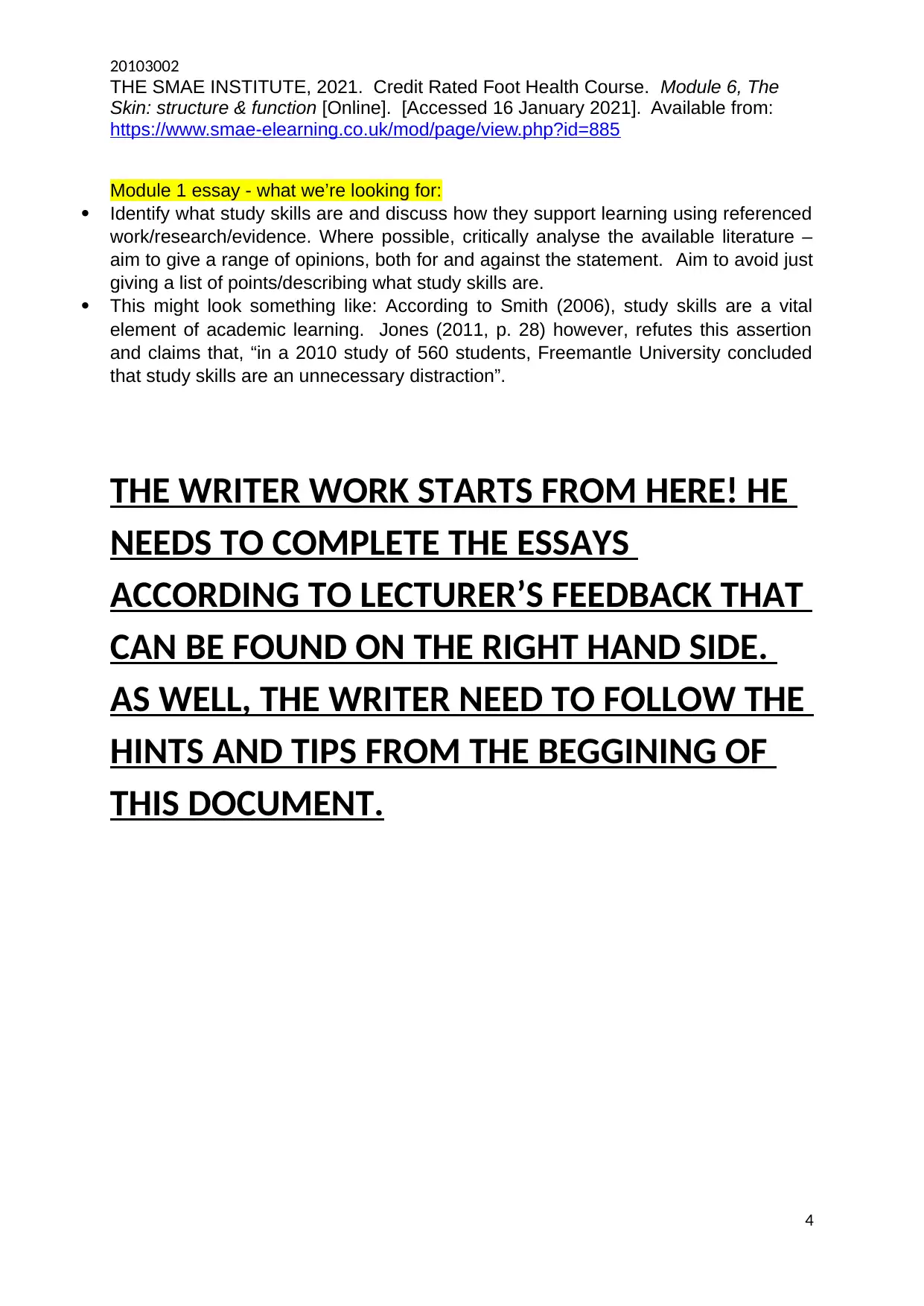
20103002
THE SMAE INSTITUTE, 2021. Credit Rated Foot Health Course. Module 6, The
Skin: structure & function [Online]. [Accessed 16 January 2021]. Available from:
https://www.smae-elearning.co.uk/mod/page/view.php?id=885
Module 1 essay - what we’re looking for:
Identify what study skills are and discuss how they support learning using referenced
work/research/evidence. Where possible, critically analyse the available literature –
aim to give a range of opinions, both for and against the statement. Aim to avoid just
giving a list of points/describing what study skills are.
This might look something like: According to Smith (2006), study skills are a vital
element of academic learning. Jones (2011, p. 28) however, refutes this assertion
and claims that, “in a 2010 study of 560 students, Freemantle University concluded
that study skills are an unnecessary distraction”.
THE WRITER WORK STARTS FROM HERE! HE
NEEDS TO COMPLETE THE ESSAYS
ACCORDING TO LECTURER’S FEEDBACK THAT
CAN BE FOUND ON THE RIGHT HAND SIDE.
AS WELL, THE WRITER NEED TO FOLLOW THE
HINTS AND TIPS FROM THE BEGGINING OF
THIS DOCUMENT.
4
THE SMAE INSTITUTE, 2021. Credit Rated Foot Health Course. Module 6, The
Skin: structure & function [Online]. [Accessed 16 January 2021]. Available from:
https://www.smae-elearning.co.uk/mod/page/view.php?id=885
Module 1 essay - what we’re looking for:
Identify what study skills are and discuss how they support learning using referenced
work/research/evidence. Where possible, critically analyse the available literature –
aim to give a range of opinions, both for and against the statement. Aim to avoid just
giving a list of points/describing what study skills are.
This might look something like: According to Smith (2006), study skills are a vital
element of academic learning. Jones (2011, p. 28) however, refutes this assertion
and claims that, “in a 2010 study of 560 students, Freemantle University concluded
that study skills are an unnecessary distraction”.
THE WRITER WORK STARTS FROM HERE! HE
NEEDS TO COMPLETE THE ESSAYS
ACCORDING TO LECTURER’S FEEDBACK THAT
CAN BE FOUND ON THE RIGHT HAND SIDE.
AS WELL, THE WRITER NEED TO FOLLOW THE
HINTS AND TIPS FROM THE BEGGINING OF
THIS DOCUMENT.
4
Secure Best Marks with AI Grader
Need help grading? Try our AI Grader for instant feedback on your assignments.
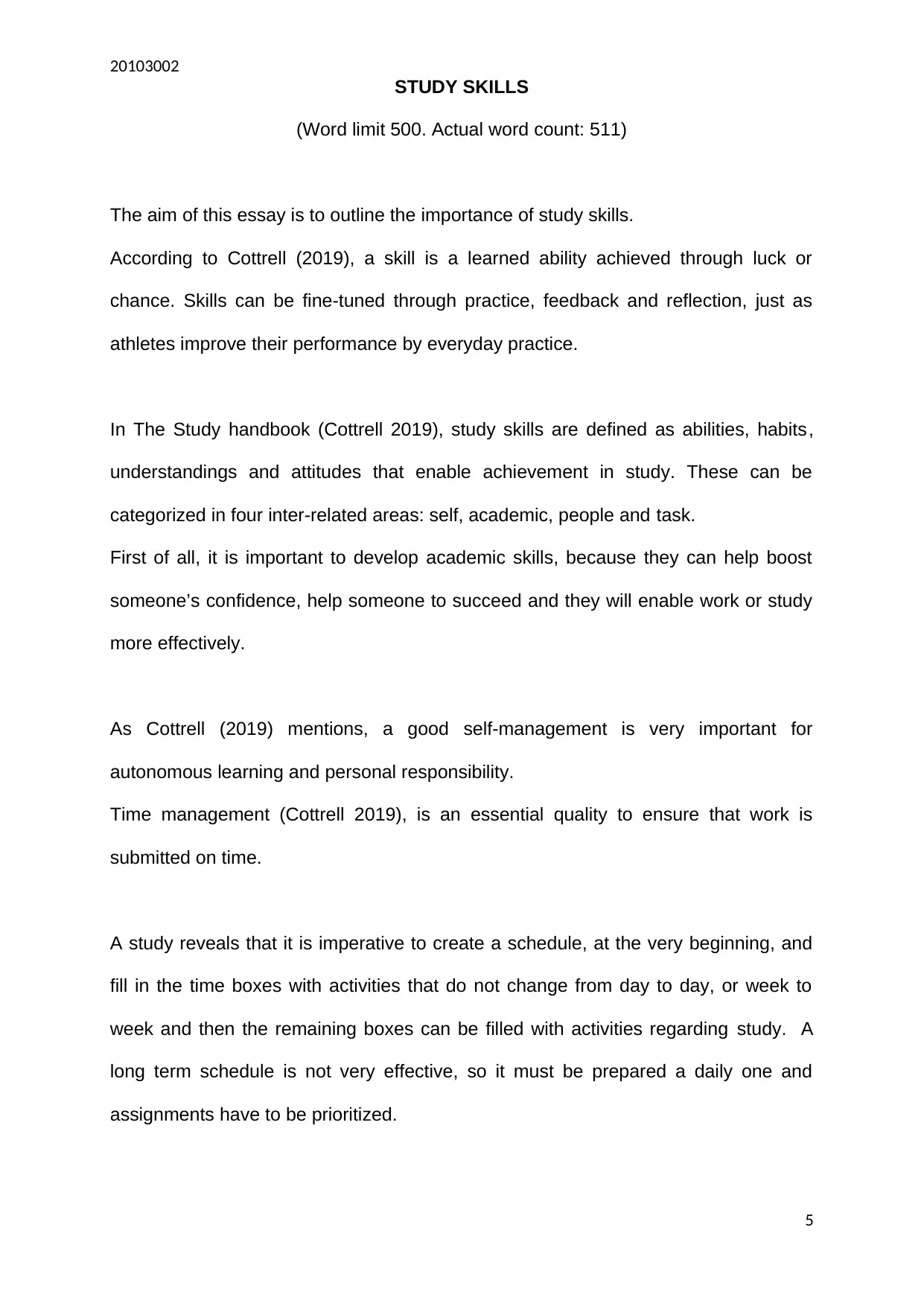
20103002
STUDY SKILLS
(Word limit 500. Actual word count: 511)
The aim of this essay is to outline the importance of study skills.
According to Cottrell (2019), a skill is a learned ability achieved through luck or
chance. Skills can be fine-tuned through practice, feedback and reflection, just as
athletes improve their performance by everyday practice.
In The Study handbook (Cottrell 2019), study skills are defined as abilities, habits,
understandings and attitudes that enable achievement in study. These can be
categorized in four inter-related areas: self, academic, people and task.
First of all, it is important to develop academic skills, because they can help boost
someone’s confidence, help someone to succeed and they will enable work or study
more effectively.
As Cottrell (2019) mentions, a good self-management is very important for
autonomous learning and personal responsibility.
Time management (Cottrell 2019), is an essential quality to ensure that work is
submitted on time.
A study reveals that it is imperative to create a schedule, at the very beginning, and
fill in the time boxes with activities that do not change from day to day, or week to
week and then the remaining boxes can be filled with activities regarding study. A
long term schedule is not very effective, so it must be prepared a daily one and
assignments have to be prioritized.
5
STUDY SKILLS
(Word limit 500. Actual word count: 511)
The aim of this essay is to outline the importance of study skills.
According to Cottrell (2019), a skill is a learned ability achieved through luck or
chance. Skills can be fine-tuned through practice, feedback and reflection, just as
athletes improve their performance by everyday practice.
In The Study handbook (Cottrell 2019), study skills are defined as abilities, habits,
understandings and attitudes that enable achievement in study. These can be
categorized in four inter-related areas: self, academic, people and task.
First of all, it is important to develop academic skills, because they can help boost
someone’s confidence, help someone to succeed and they will enable work or study
more effectively.
As Cottrell (2019) mentions, a good self-management is very important for
autonomous learning and personal responsibility.
Time management (Cottrell 2019), is an essential quality to ensure that work is
submitted on time.
A study reveals that it is imperative to create a schedule, at the very beginning, and
fill in the time boxes with activities that do not change from day to day, or week to
week and then the remaining boxes can be filled with activities regarding study. A
long term schedule is not very effective, so it must be prepared a daily one and
assignments have to be prioritized.
5
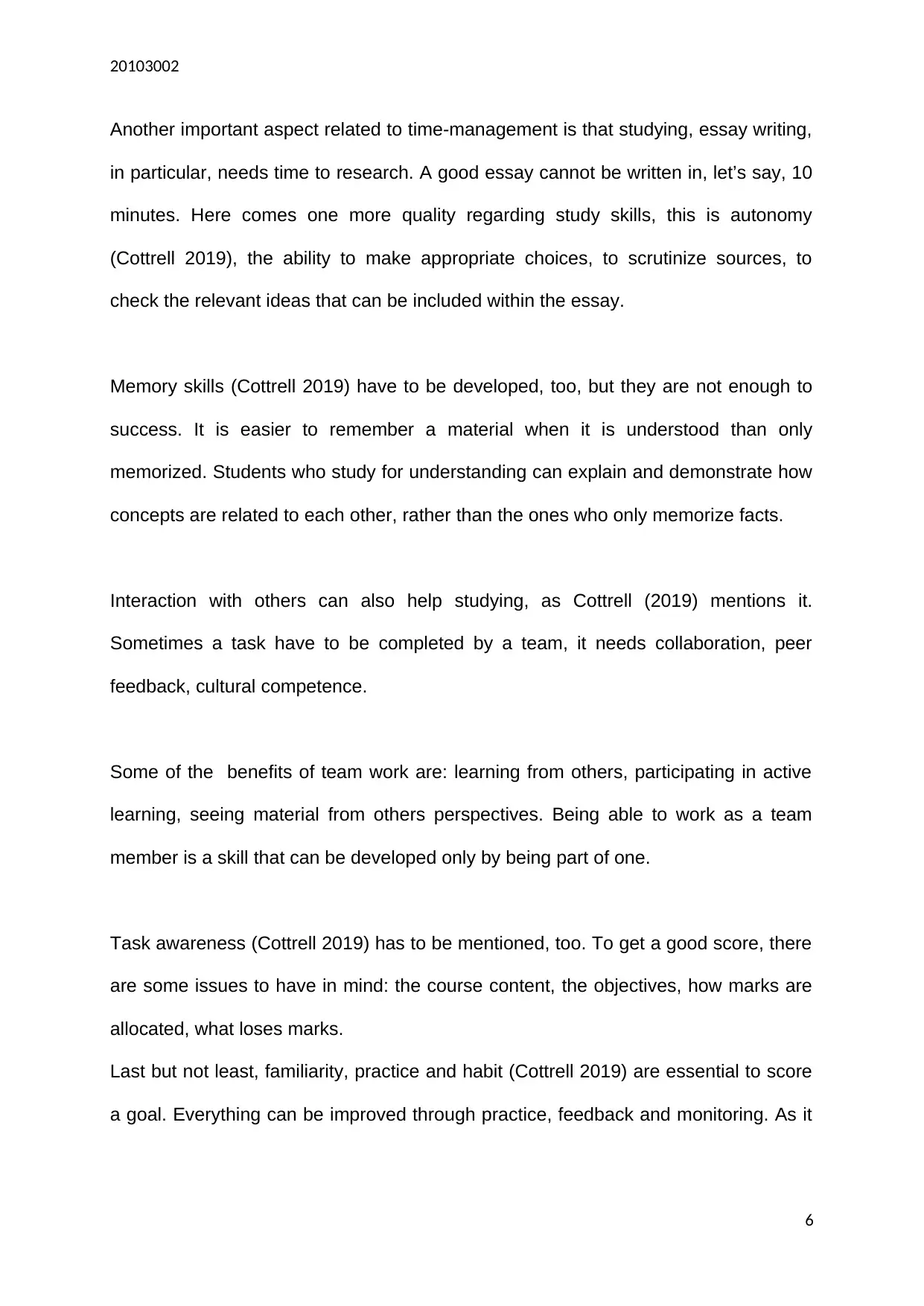
20103002
Another important aspect related to time-management is that studying, essay writing,
in particular, needs time to research. A good essay cannot be written in, let’s say, 10
minutes. Here comes one more quality regarding study skills, this is autonomy
(Cottrell 2019), the ability to make appropriate choices, to scrutinize sources, to
check the relevant ideas that can be included within the essay.
Memory skills (Cottrell 2019) have to be developed, too, but they are not enough to
success. It is easier to remember a material when it is understood than only
memorized. Students who study for understanding can explain and demonstrate how
concepts are related to each other, rather than the ones who only memorize facts.
Interaction with others can also help studying, as Cottrell (2019) mentions it.
Sometimes a task have to be completed by a team, it needs collaboration, peer
feedback, cultural competence.
Some of the benefits of team work are: learning from others, participating in active
learning, seeing material from others perspectives. Being able to work as a team
member is a skill that can be developed only by being part of one.
Task awareness (Cottrell 2019) has to be mentioned, too. To get a good score, there
are some issues to have in mind: the course content, the objectives, how marks are
allocated, what loses marks.
Last but not least, familiarity, practice and habit (Cottrell 2019) are essential to score
a goal. Everything can be improved through practice, feedback and monitoring. As it
6
Another important aspect related to time-management is that studying, essay writing,
in particular, needs time to research. A good essay cannot be written in, let’s say, 10
minutes. Here comes one more quality regarding study skills, this is autonomy
(Cottrell 2019), the ability to make appropriate choices, to scrutinize sources, to
check the relevant ideas that can be included within the essay.
Memory skills (Cottrell 2019) have to be developed, too, but they are not enough to
success. It is easier to remember a material when it is understood than only
memorized. Students who study for understanding can explain and demonstrate how
concepts are related to each other, rather than the ones who only memorize facts.
Interaction with others can also help studying, as Cottrell (2019) mentions it.
Sometimes a task have to be completed by a team, it needs collaboration, peer
feedback, cultural competence.
Some of the benefits of team work are: learning from others, participating in active
learning, seeing material from others perspectives. Being able to work as a team
member is a skill that can be developed only by being part of one.
Task awareness (Cottrell 2019) has to be mentioned, too. To get a good score, there
are some issues to have in mind: the course content, the objectives, how marks are
allocated, what loses marks.
Last but not least, familiarity, practice and habit (Cottrell 2019) are essential to score
a goal. Everything can be improved through practice, feedback and monitoring. As it
6

20103002
is said, “repetition is the mother of all learning”, practice is the way to stay focused
longer, to perform skills automatically.
In conclusion, it would appear that just one skill is not enough to succeed, everyone
needs to combine them and one cannot work without the other.
References
Stella Cottrell 2019, The Study Skills Handbook, 5th edition, Red Globe Press
https://www.educationcorner.com/effective-time-management.html
https://www.skillsyouneed.com/learn/sources-info.html
https://dus.psu.edu/academicsuccess/studyskills.html#understanding
7
is said, “repetition is the mother of all learning”, practice is the way to stay focused
longer, to perform skills automatically.
In conclusion, it would appear that just one skill is not enough to succeed, everyone
needs to combine them and one cannot work without the other.
References
Stella Cottrell 2019, The Study Skills Handbook, 5th edition, Red Globe Press
https://www.educationcorner.com/effective-time-management.html
https://www.skillsyouneed.com/learn/sources-info.html
https://dus.psu.edu/academicsuccess/studyskills.html#understanding
7
Paraphrase This Document
Need a fresh take? Get an instant paraphrase of this document with our AI Paraphraser
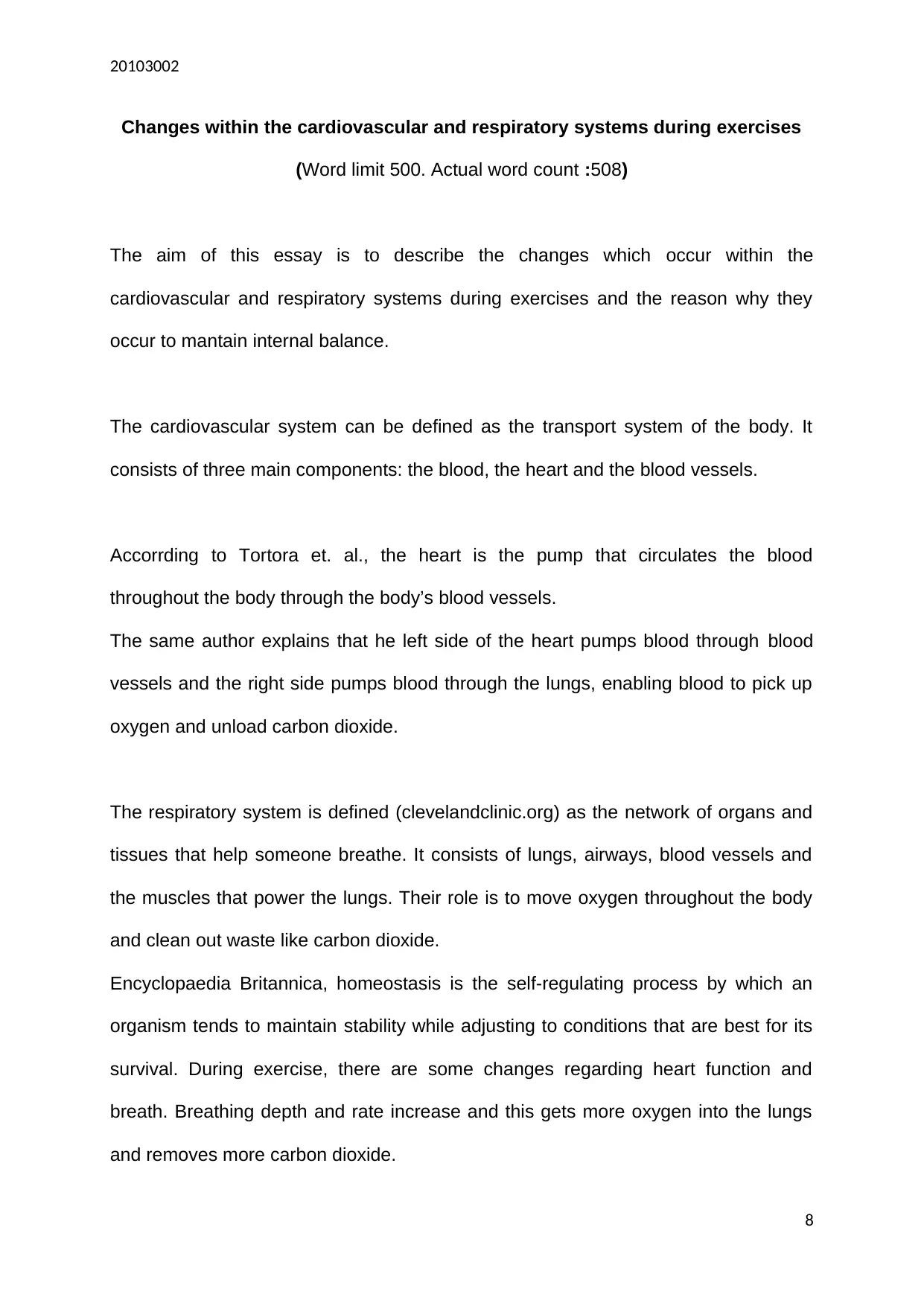
20103002
Changes within the cardiovascular and respiratory systems during exercises
(Word limit 500. Actual word count :508)
The aim of this essay is to describe the changes which occur within the
cardiovascular and respiratory systems during exercises and the reason why they
occur to mantain internal balance.
The cardiovascular system can be defined as the transport system of the body. It
consists of three main components: the blood, the heart and the blood vessels.
Accorrding to Tortora et. al., the heart is the pump that circulates the blood
throughout the body through the body’s blood vessels.
The same author explains that he left side of the heart pumps blood through blood
vessels and the right side pumps blood through the lungs, enabling blood to pick up
oxygen and unload carbon dioxide.
The respiratory system is defined (clevelandclinic.org) as the network of organs and
tissues that help someone breathe. It consists of lungs, airways, blood vessels and
the muscles that power the lungs. Their role is to move oxygen throughout the body
and clean out waste like carbon dioxide.
Encyclopaedia Britannica, homeostasis is the self-regulating process by which an
organism tends to maintain stability while adjusting to conditions that are best for its
survival. During exercise, there are some changes regarding heart function and
breath. Breathing depth and rate increase and this gets more oxygen into the lungs
and removes more carbon dioxide.
8
Changes within the cardiovascular and respiratory systems during exercises
(Word limit 500. Actual word count :508)
The aim of this essay is to describe the changes which occur within the
cardiovascular and respiratory systems during exercises and the reason why they
occur to mantain internal balance.
The cardiovascular system can be defined as the transport system of the body. It
consists of three main components: the blood, the heart and the blood vessels.
Accorrding to Tortora et. al., the heart is the pump that circulates the blood
throughout the body through the body’s blood vessels.
The same author explains that he left side of the heart pumps blood through blood
vessels and the right side pumps blood through the lungs, enabling blood to pick up
oxygen and unload carbon dioxide.
The respiratory system is defined (clevelandclinic.org) as the network of organs and
tissues that help someone breathe. It consists of lungs, airways, blood vessels and
the muscles that power the lungs. Their role is to move oxygen throughout the body
and clean out waste like carbon dioxide.
Encyclopaedia Britannica, homeostasis is the self-regulating process by which an
organism tends to maintain stability while adjusting to conditions that are best for its
survival. During exercise, there are some changes regarding heart function and
breath. Breathing depth and rate increase and this gets more oxygen into the lungs
and removes more carbon dioxide.
8
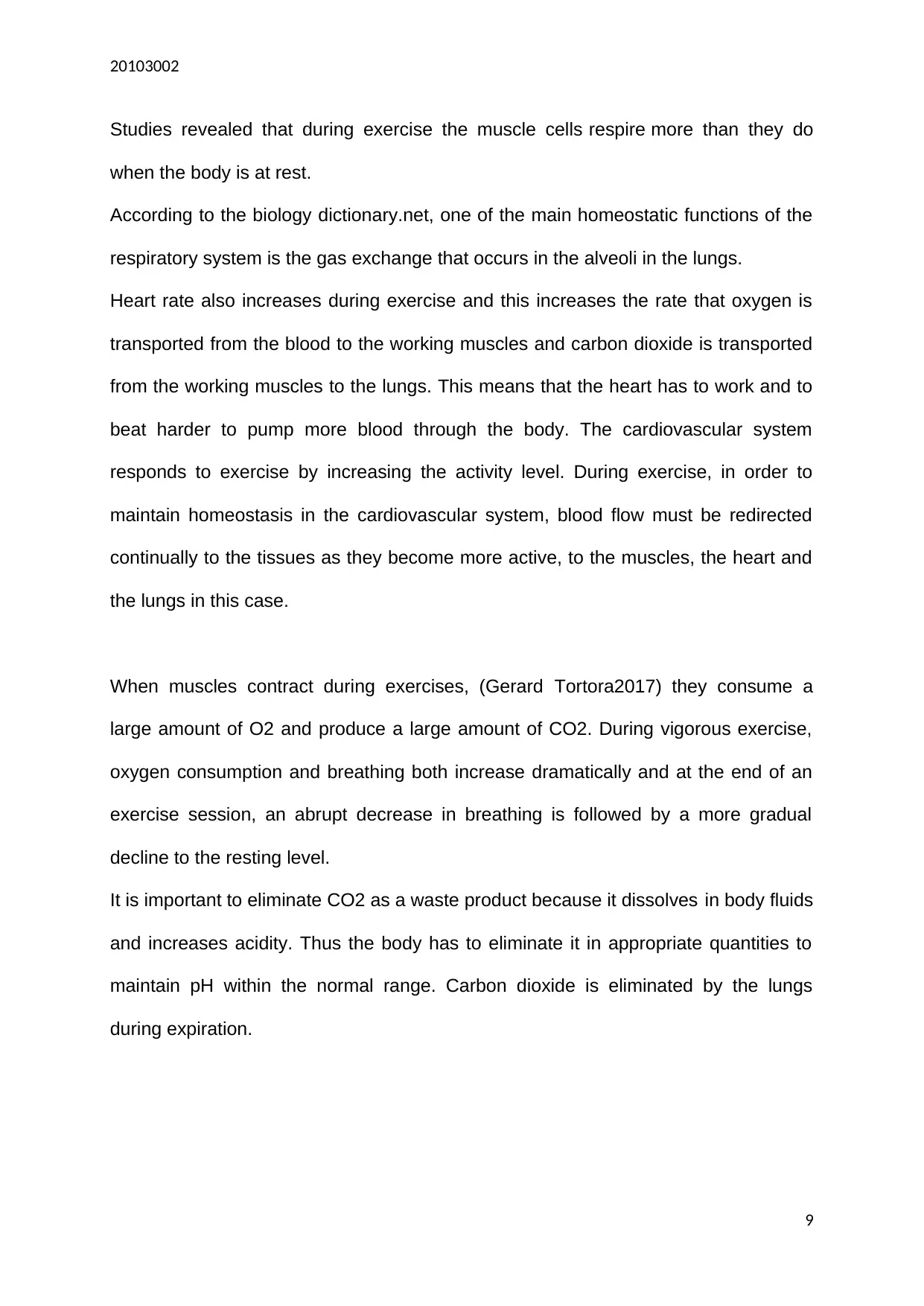
20103002
Studies revealed that during exercise the muscle cells respire more than they do
when the body is at rest.
According to the biology dictionary.net, one of the main homeostatic functions of the
respiratory system is the gas exchange that occurs in the alveoli in the lungs.
Heart rate also increases during exercise and this increases the rate that oxygen is
transported from the blood to the working muscles and carbon dioxide is transported
from the working muscles to the lungs. This means that the heart has to work and to
beat harder to pump more blood through the body. The cardiovascular system
responds to exercise by increasing the activity level. During exercise, in order to
maintain homeostasis in the cardiovascular system, blood flow must be redirected
continually to the tissues as they become more active, to the muscles, the heart and
the lungs in this case.
When muscles contract during exercises, (Gerard Tortora2017) they consume a
large amount of O2 and produce a large amount of CO2. During vigorous exercise,
oxygen consumption and breathing both increase dramatically and at the end of an
exercise session, an abrupt decrease in breathing is followed by a more gradual
decline to the resting level.
It is important to eliminate CO2 as a waste product because it dissolves in body fluids
and increases acidity. Thus the body has to eliminate it in appropriate quantities to
maintain pH within the normal range. Carbon dioxide is eliminated by the lungs
during expiration.
9
Studies revealed that during exercise the muscle cells respire more than they do
when the body is at rest.
According to the biology dictionary.net, one of the main homeostatic functions of the
respiratory system is the gas exchange that occurs in the alveoli in the lungs.
Heart rate also increases during exercise and this increases the rate that oxygen is
transported from the blood to the working muscles and carbon dioxide is transported
from the working muscles to the lungs. This means that the heart has to work and to
beat harder to pump more blood through the body. The cardiovascular system
responds to exercise by increasing the activity level. During exercise, in order to
maintain homeostasis in the cardiovascular system, blood flow must be redirected
continually to the tissues as they become more active, to the muscles, the heart and
the lungs in this case.
When muscles contract during exercises, (Gerard Tortora2017) they consume a
large amount of O2 and produce a large amount of CO2. During vigorous exercise,
oxygen consumption and breathing both increase dramatically and at the end of an
exercise session, an abrupt decrease in breathing is followed by a more gradual
decline to the resting level.
It is important to eliminate CO2 as a waste product because it dissolves in body fluids
and increases acidity. Thus the body has to eliminate it in appropriate quantities to
maintain pH within the normal range. Carbon dioxide is eliminated by the lungs
during expiration.
9

20103002
In conclusion, the two systems, the cardiovascular and the respiratory one, have to
work together to get O2 to the working muscles during exercise and to remove CO2
from the body as a waste product.
References
Gerard J. Tortora, Bryan H. Derrickson- Tortora’s principles of Anatomy &Physiology,
Global edition, 2017
https://healthengine.com.au/info/cardiovascular-system-heart
https://my.clevelandclinic.org/health/articles/21205-respiratory-system
https://www.britannica.com/science/homeostasis
https://www.bbc.co.uk/bitesize/guides/zpd4wxs/revision/3
https://www.bbc.co.uk/bitesize/guides/z6h4jxs/revision/4
https://biologydictionary.net/how-does-the-respiratory-system-maintain-homeostasis/
https://www.ukessays.com/essays/physical-education/cardiovascular-respiratory-
system-during-exercise-physical-education-essay.php
https://courses.lumenlearning.com/suny-ap2/chapter/homeostatic-regulation-of-the-
vascular-system/
https://courses.lumenlearning.com/suny-ap2/chapter/homeostatic-regulation-of-the-
vascular-system/
http://www.anaphy.com/elimination-of-wastes/
10
In conclusion, the two systems, the cardiovascular and the respiratory one, have to
work together to get O2 to the working muscles during exercise and to remove CO2
from the body as a waste product.
References
Gerard J. Tortora, Bryan H. Derrickson- Tortora’s principles of Anatomy &Physiology,
Global edition, 2017
https://healthengine.com.au/info/cardiovascular-system-heart
https://my.clevelandclinic.org/health/articles/21205-respiratory-system
https://www.britannica.com/science/homeostasis
https://www.bbc.co.uk/bitesize/guides/zpd4wxs/revision/3
https://www.bbc.co.uk/bitesize/guides/z6h4jxs/revision/4
https://biologydictionary.net/how-does-the-respiratory-system-maintain-homeostasis/
https://www.ukessays.com/essays/physical-education/cardiovascular-respiratory-
system-during-exercise-physical-education-essay.php
https://courses.lumenlearning.com/suny-ap2/chapter/homeostatic-regulation-of-the-
vascular-system/
https://courses.lumenlearning.com/suny-ap2/chapter/homeostatic-regulation-of-the-
vascular-system/
http://www.anaphy.com/elimination-of-wastes/
10
Secure Best Marks with AI Grader
Need help grading? Try our AI Grader for instant feedback on your assignments.
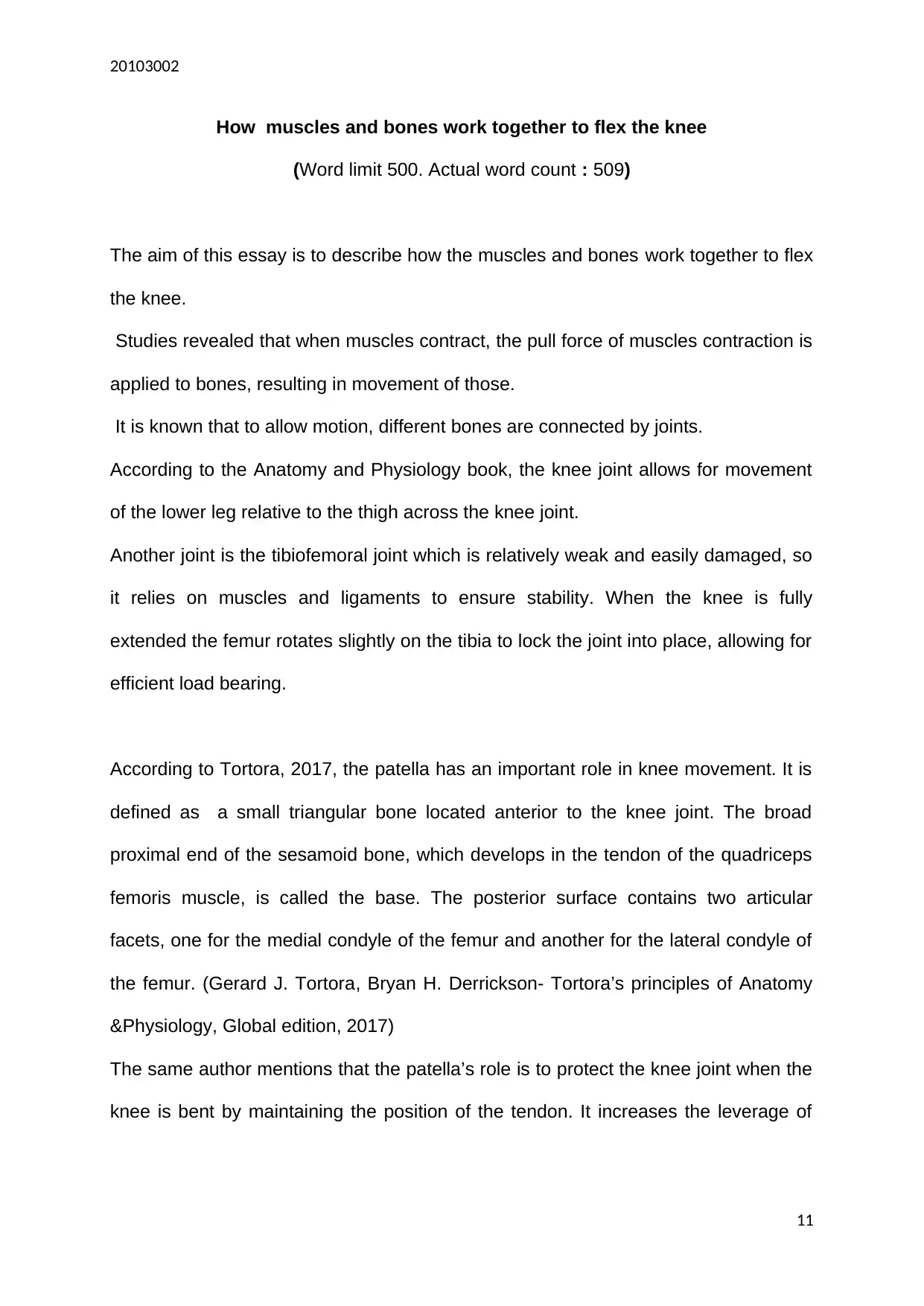
20103002
How muscles and bones work together to flex the knee
(Word limit 500. Actual word count : 509)
The aim of this essay is to describe how the muscles and bones work together to flex
the knee.
Studies revealed that when muscles contract, the pull force of muscles contraction is
applied to bones, resulting in movement of those.
It is known that to allow motion, different bones are connected by joints.
According to the Anatomy and Physiology book, the knee joint allows for movement
of the lower leg relative to the thigh across the knee joint.
Another joint is the tibiofemoral joint which is relatively weak and easily damaged, so
it relies on muscles and ligaments to ensure stability. When the knee is fully
extended the femur rotates slightly on the tibia to lock the joint into place, allowing for
efficient load bearing.
According to Tortora, 2017, the patella has an important role in knee movement. It is
defined as a small triangular bone located anterior to the knee joint. The broad
proximal end of the sesamoid bone, which develops in the tendon of the quadriceps
femoris muscle, is called the base. The posterior surface contains two articular
facets, one for the medial condyle of the femur and another for the lateral condyle of
the femur. (Gerard J. Tortora, Bryan H. Derrickson- Tortora’s principles of Anatomy
&Physiology, Global edition, 2017)
The same author mentions that the patella’s role is to protect the knee joint when the
knee is bent by maintaining the position of the tendon. It increases the leverage of
11
How muscles and bones work together to flex the knee
(Word limit 500. Actual word count : 509)
The aim of this essay is to describe how the muscles and bones work together to flex
the knee.
Studies revealed that when muscles contract, the pull force of muscles contraction is
applied to bones, resulting in movement of those.
It is known that to allow motion, different bones are connected by joints.
According to the Anatomy and Physiology book, the knee joint allows for movement
of the lower leg relative to the thigh across the knee joint.
Another joint is the tibiofemoral joint which is relatively weak and easily damaged, so
it relies on muscles and ligaments to ensure stability. When the knee is fully
extended the femur rotates slightly on the tibia to lock the joint into place, allowing for
efficient load bearing.
According to Tortora, 2017, the patella has an important role in knee movement. It is
defined as a small triangular bone located anterior to the knee joint. The broad
proximal end of the sesamoid bone, which develops in the tendon of the quadriceps
femoris muscle, is called the base. The posterior surface contains two articular
facets, one for the medial condyle of the femur and another for the lateral condyle of
the femur. (Gerard J. Tortora, Bryan H. Derrickson- Tortora’s principles of Anatomy
&Physiology, Global edition, 2017)
The same author mentions that the patella’s role is to protect the knee joint when the
knee is bent by maintaining the position of the tendon. It increases the leverage of
11

20103002
the tendon of the quadriceps femoris muscle. (Gerard J. Tortora, Bryan H.
Derrickson- Tortora’s principles of Anatomy &Physiology, Global edition, 2017)
Muscles that generate movement across the knee are located in the thigh and can be
split into anterior and posterior compartments, as it is mentioned in the Anatomy and
Physiology Book.
There are four muscles in the anterior region of the thigh: Sartorius, quadriceps
femoris, pectineus and ilopsoas.
The sartorius is a thin muscle which helps flexing the lower leg at the knee joint. It si
the body’s longest muscle and it originates from the pelvis and attaches to the tibia.
The quadriceps femoris is composed of four muscles that comprise the front of the
thigh, They stabilize and protect the patella and extend the lower leg at the knee
joint.
Regarding the posterior compartment of the thigh, there can be found three muscles:
the biceps femoris and two synergistic muscles which extend and laterally rotate the
hip. Their main action is flexing of the lower leg at the knee.
Another muscle which helps flex the knee is the popliteus. It is located behind the
knee joint and it rotates laterally the femur on the tibia unlocking the knee joint so that
flexion can occur.
As a conclusion, it can be mentioned that muscles and bones work together to flex
the knee as follows: When the leg is straightened, the quadriceps muscles pull on the
quadriceps tendon, this pulls the kneecap to make the knee extend. When the knee
is bended, the hamstring muscles contract and pull the tibia backwards, causing the
knee to flex.
References
12
the tendon of the quadriceps femoris muscle. (Gerard J. Tortora, Bryan H.
Derrickson- Tortora’s principles of Anatomy &Physiology, Global edition, 2017)
Muscles that generate movement across the knee are located in the thigh and can be
split into anterior and posterior compartments, as it is mentioned in the Anatomy and
Physiology Book.
There are four muscles in the anterior region of the thigh: Sartorius, quadriceps
femoris, pectineus and ilopsoas.
The sartorius is a thin muscle which helps flexing the lower leg at the knee joint. It si
the body’s longest muscle and it originates from the pelvis and attaches to the tibia.
The quadriceps femoris is composed of four muscles that comprise the front of the
thigh, They stabilize and protect the patella and extend the lower leg at the knee
joint.
Regarding the posterior compartment of the thigh, there can be found three muscles:
the biceps femoris and two synergistic muscles which extend and laterally rotate the
hip. Their main action is flexing of the lower leg at the knee.
Another muscle which helps flex the knee is the popliteus. It is located behind the
knee joint and it rotates laterally the femur on the tibia unlocking the knee joint so that
flexion can occur.
As a conclusion, it can be mentioned that muscles and bones work together to flex
the knee as follows: When the leg is straightened, the quadriceps muscles pull on the
quadriceps tendon, this pulls the kneecap to make the knee extend. When the knee
is bended, the hamstring muscles contract and pull the tibia backwards, causing the
knee to flex.
References
12

20103002
Gerard J. Tortora, Bryan H. Derrickson- Tortora’s principles of Anatomy &Physiology,
Global edition, 2017
https://www.google.com/search?
ei=JmQOYNadBIe_sAeO2YPgAQ&q=how+muscles+and+bones+work+together+to+
produce+movement&oq=how+muscles+&gs_lcp=CgZwc3ktYWIQARgDMgIIADICCA
AyAggAMgIIADICCAAyAggAMgIIADICCAAyAggAMgIIADoECAAQQzoICAAQsQMQ
gwE6CwgAELEDEMcBEKMCOggILhCxAxCDAToFCC4QsQM6AgguOgoIABCxAxC
DARBDOggIABDHARCvAToFCAAQsQM6BQguEJMCOgQIABAKUJA-
WKdZYMN2aABwAXgAgAGkAYgBiwiSAQQxMS4xmAEAoAEBqgEHZ3dzLXdpesAB
AQ&sclient=psy-ab
https://med.libretexts.org/Bookshelves/Anatomy_and_Physiology/Book
%3A_Anatomy_and_Physiology_(Boundless)/9%3A_Muscular_System/
9.10%3A_Muscles_of_the_Lower_Limb/9.10B
%3A_Muscles_that_Cause_Movement_at_the_Knee_Joint)
https://socratic.org/questions/how-do-muscles-and-bones-work-together
13
Gerard J. Tortora, Bryan H. Derrickson- Tortora’s principles of Anatomy &Physiology,
Global edition, 2017
https://www.google.com/search?
ei=JmQOYNadBIe_sAeO2YPgAQ&q=how+muscles+and+bones+work+together+to+
produce+movement&oq=how+muscles+&gs_lcp=CgZwc3ktYWIQARgDMgIIADICCA
AyAggAMgIIADICCAAyAggAMgIIADICCAAyAggAMgIIADoECAAQQzoICAAQsQMQ
gwE6CwgAELEDEMcBEKMCOggILhCxAxCDAToFCC4QsQM6AgguOgoIABCxAxC
DARBDOggIABDHARCvAToFCAAQsQM6BQguEJMCOgQIABAKUJA-
WKdZYMN2aABwAXgAgAGkAYgBiwiSAQQxMS4xmAEAoAEBqgEHZ3dzLXdpesAB
AQ&sclient=psy-ab
https://med.libretexts.org/Bookshelves/Anatomy_and_Physiology/Book
%3A_Anatomy_and_Physiology_(Boundless)/9%3A_Muscular_System/
9.10%3A_Muscles_of_the_Lower_Limb/9.10B
%3A_Muscles_that_Cause_Movement_at_the_Knee_Joint)
https://socratic.org/questions/how-do-muscles-and-bones-work-together
13
Paraphrase This Document
Need a fresh take? Get an instant paraphrase of this document with our AI Paraphraser
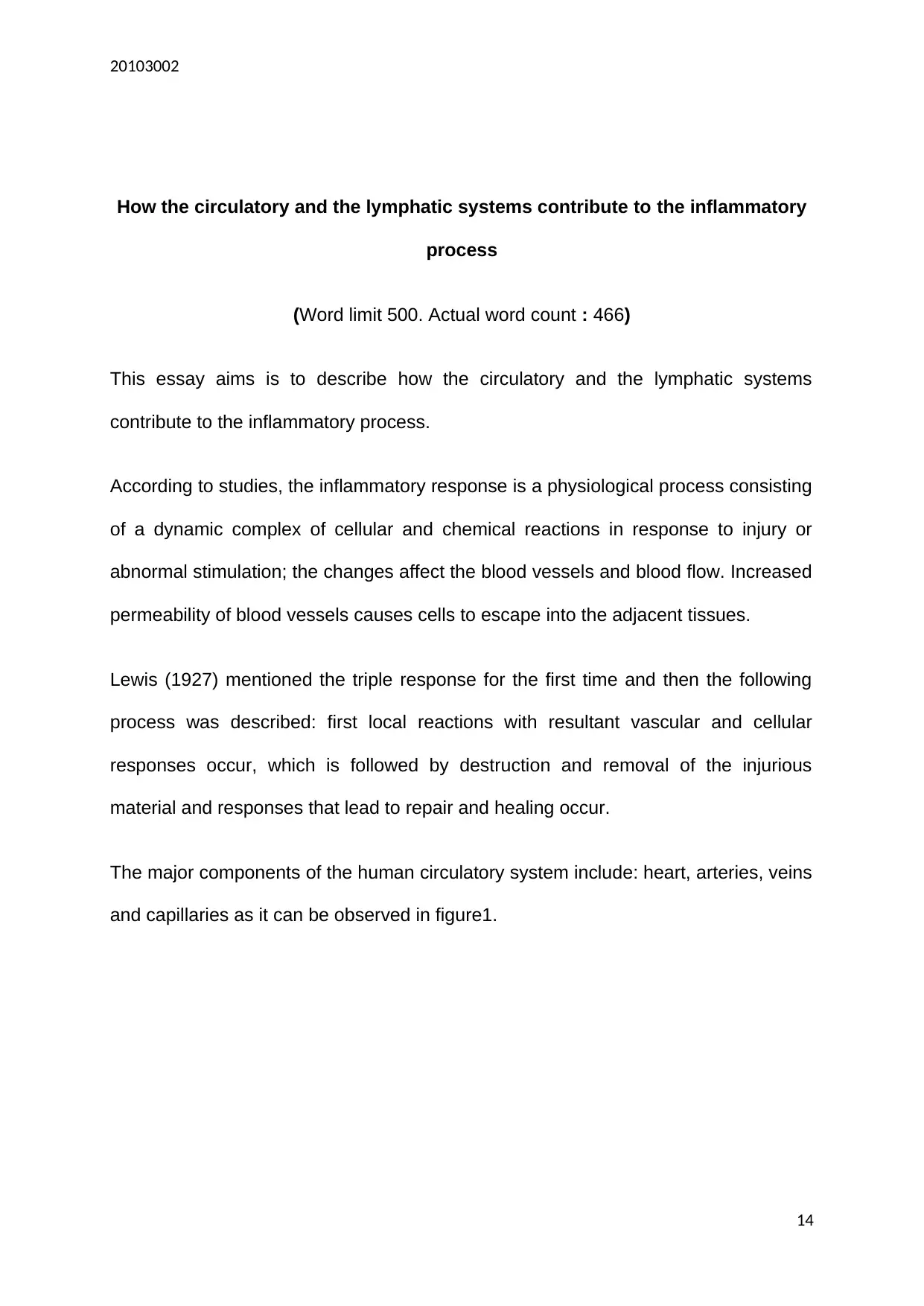
20103002
How the circulatory and the lymphatic systems contribute to the inflammatory
process
(Word limit 500. Actual word count : 466)
This essay aims is to describe how the circulatory and the lymphatic systems
contribute to the inflammatory process.
According to studies, the inflammatory response is a physiological process consisting
of a dynamic complex of cellular and chemical reactions in response to injury or
abnormal stimulation; the changes affect the blood vessels and blood flow. Increased
permeability of blood vessels causes cells to escape into the adjacent tissues.
Lewis (1927) mentioned the triple response for the first time and then the following
process was described: first local reactions with resultant vascular and cellular
responses occur, which is followed by destruction and removal of the injurious
material and responses that lead to repair and healing occur.
The major components of the human circulatory system include: heart, arteries, veins
and capillaries as it can be observed in figure1.
14
How the circulatory and the lymphatic systems contribute to the inflammatory
process
(Word limit 500. Actual word count : 466)
This essay aims is to describe how the circulatory and the lymphatic systems
contribute to the inflammatory process.
According to studies, the inflammatory response is a physiological process consisting
of a dynamic complex of cellular and chemical reactions in response to injury or
abnormal stimulation; the changes affect the blood vessels and blood flow. Increased
permeability of blood vessels causes cells to escape into the adjacent tissues.
Lewis (1927) mentioned the triple response for the first time and then the following
process was described: first local reactions with resultant vascular and cellular
responses occur, which is followed by destruction and removal of the injurious
material and responses that lead to repair and healing occur.
The major components of the human circulatory system include: heart, arteries, veins
and capillaries as it can be observed in figure1.
14
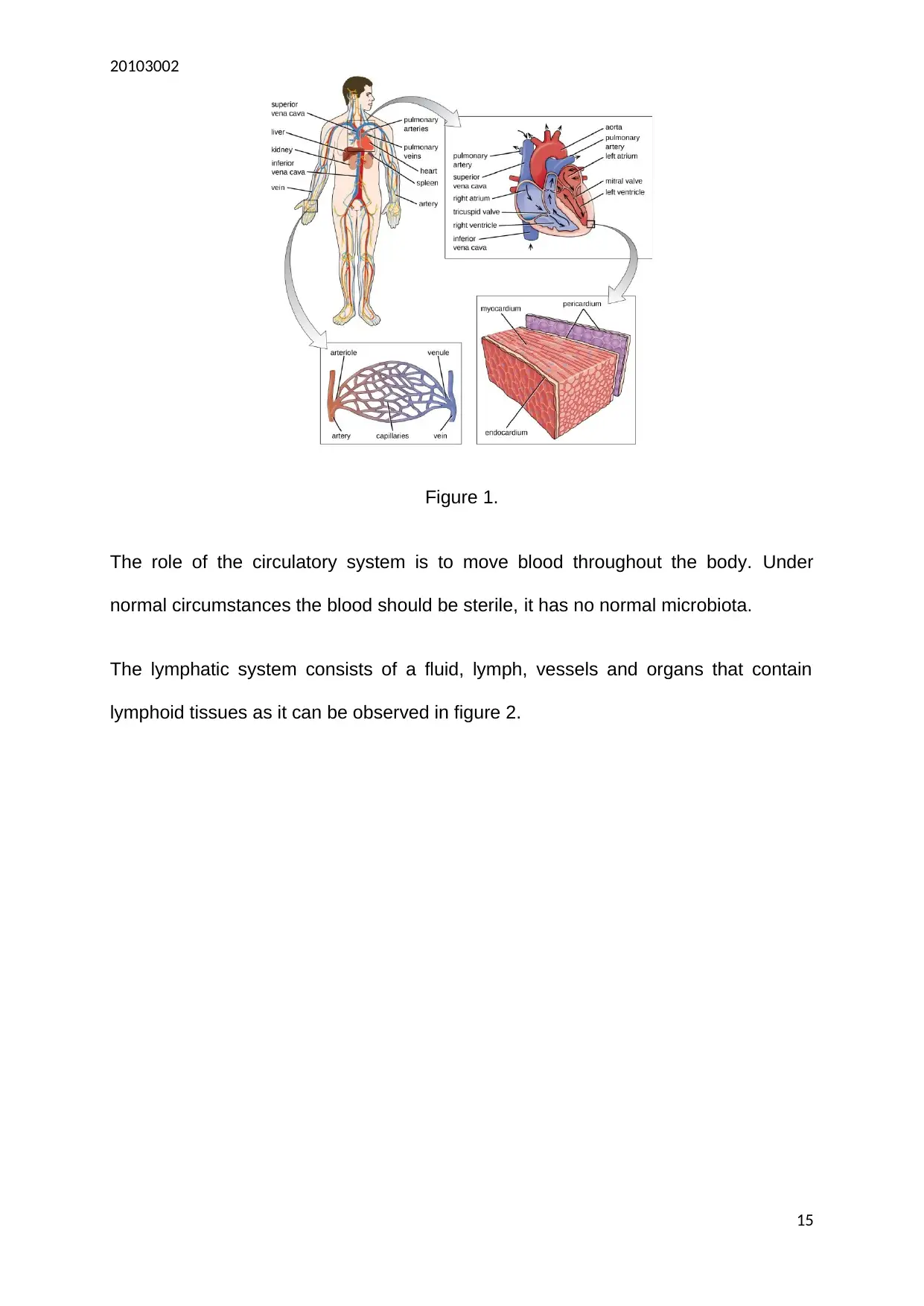
20103002
Figure 1.
The role of the circulatory system is to move blood throughout the body. Under
normal circumstances the blood should be sterile, it has no normal microbiota.
The lymphatic system consists of a fluid, lymph, vessels and organs that contain
lymphoid tissues as it can be observed in figure 2.
15
Figure 1.
The role of the circulatory system is to move blood throughout the body. Under
normal circumstances the blood should be sterile, it has no normal microbiota.
The lymphatic system consists of a fluid, lymph, vessels and organs that contain
lymphoid tissues as it can be observed in figure 2.
15
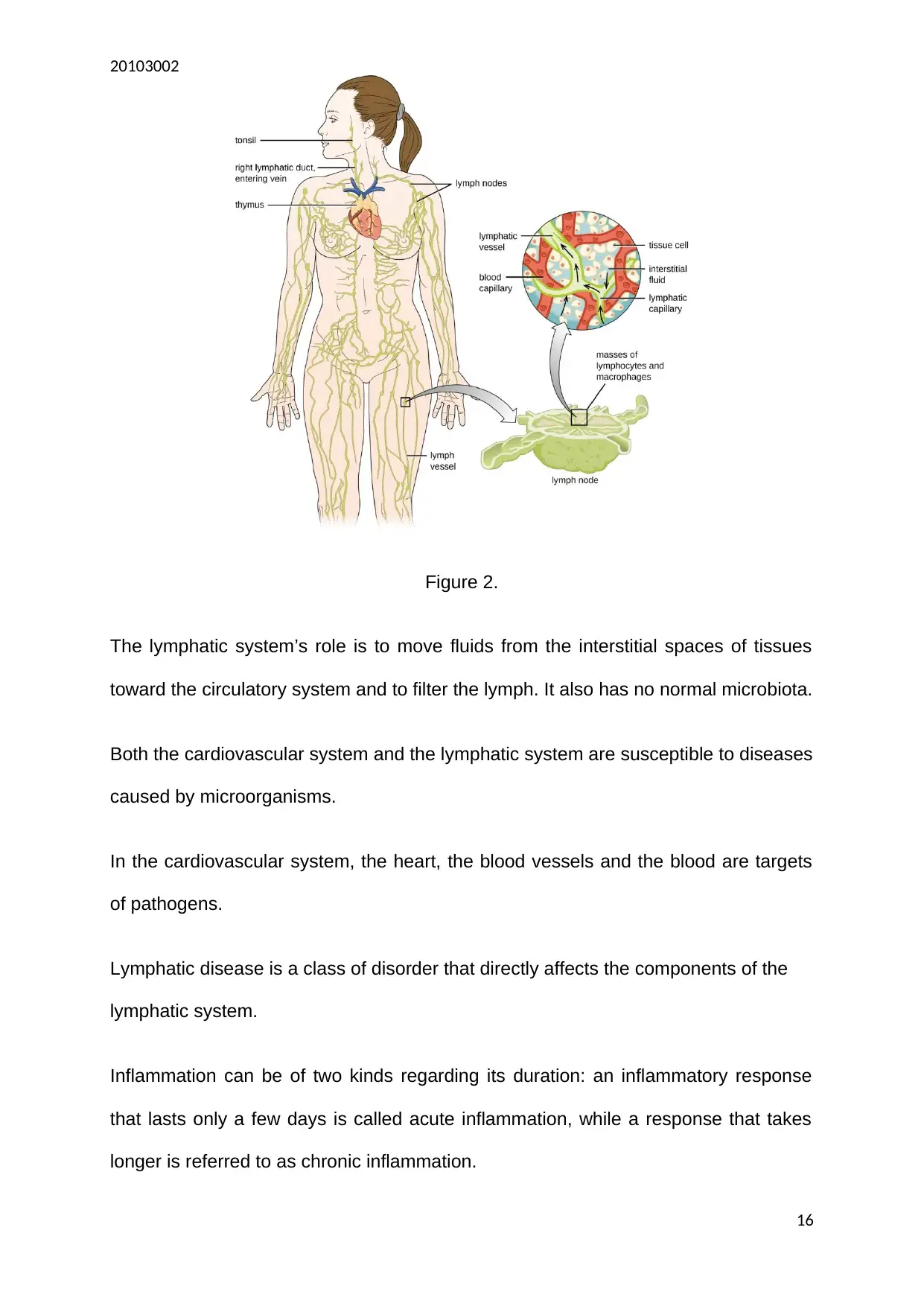
20103002
Figure 2.
The lymphatic system’s role is to move fluids from the interstitial spaces of tissues
toward the circulatory system and to filter the lymph. It also has no normal microbiota.
Both the cardiovascular system and the lymphatic system are susceptible to diseases
caused by microorganisms.
In the cardiovascular system, the heart, the blood vessels and the blood are targets
of pathogens.
Lymphatic disease is a class of disorder that directly affects the components of the
lymphatic system.
Inflammation can be of two kinds regarding its duration: an inflammatory response
that lasts only a few days is called acute inflammation, while a response that takes
longer is referred to as chronic inflammation.
16
Figure 2.
The lymphatic system’s role is to move fluids from the interstitial spaces of tissues
toward the circulatory system and to filter the lymph. It also has no normal microbiota.
Both the cardiovascular system and the lymphatic system are susceptible to diseases
caused by microorganisms.
In the cardiovascular system, the heart, the blood vessels and the blood are targets
of pathogens.
Lymphatic disease is a class of disorder that directly affects the components of the
lymphatic system.
Inflammation can be of two kinds regarding its duration: an inflammatory response
that lasts only a few days is called acute inflammation, while a response that takes
longer is referred to as chronic inflammation.
16
Secure Best Marks with AI Grader
Need help grading? Try our AI Grader for instant feedback on your assignments.
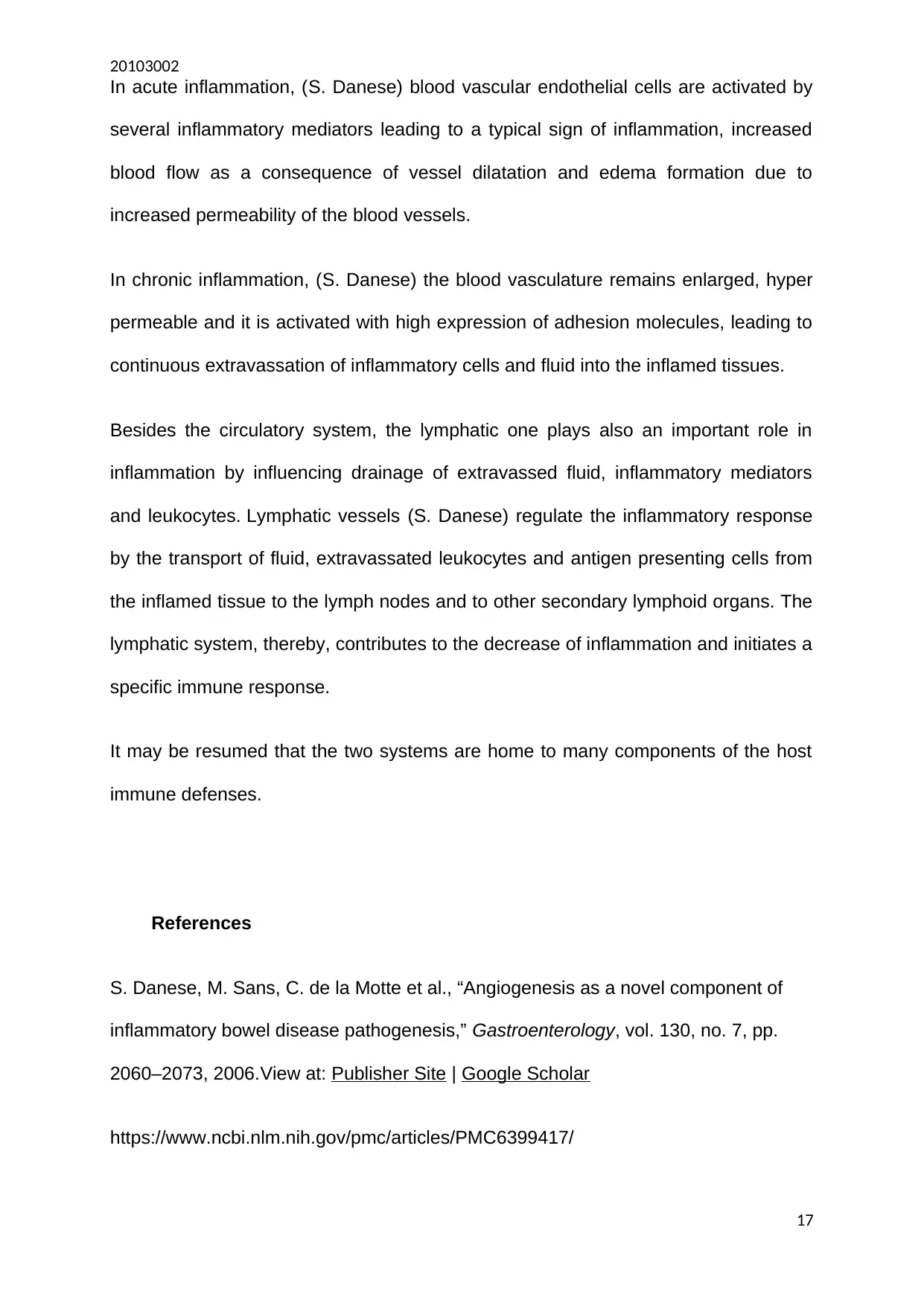
20103002
In acute inflammation, (S. Danese) blood vascular endothelial cells are activated by
several inflammatory mediators leading to a typical sign of inflammation, increased
blood flow as a consequence of vessel dilatation and edema formation due to
increased permeability of the blood vessels.
In chronic inflammation, (S. Danese) the blood vasculature remains enlarged, hyper
permeable and it is activated with high expression of adhesion molecules, leading to
continuous extravassation of inflammatory cells and fluid into the inflamed tissues.
Besides the circulatory system, the lymphatic one plays also an important role in
inflammation by influencing drainage of extravassed fluid, inflammatory mediators
and leukocytes. Lymphatic vessels (S. Danese) regulate the inflammatory response
by the transport of fluid, extravassated leukocytes and antigen presenting cells from
the inflamed tissue to the lymph nodes and to other secondary lymphoid organs. The
lymphatic system, thereby, contributes to the decrease of inflammation and initiates a
specific immune response.
It may be resumed that the two systems are home to many components of the host
immune defenses.
References
S. Danese, M. Sans, C. de la Motte et al., “Angiogenesis as a novel component of
inflammatory bowel disease pathogenesis,” Gastroenterology, vol. 130, no. 7, pp.
2060–2073, 2006.View at: Publisher Site | Google Scholar
https://www.ncbi.nlm.nih.gov/pmc/articles/PMC6399417/
17
In acute inflammation, (S. Danese) blood vascular endothelial cells are activated by
several inflammatory mediators leading to a typical sign of inflammation, increased
blood flow as a consequence of vessel dilatation and edema formation due to
increased permeability of the blood vessels.
In chronic inflammation, (S. Danese) the blood vasculature remains enlarged, hyper
permeable and it is activated with high expression of adhesion molecules, leading to
continuous extravassation of inflammatory cells and fluid into the inflamed tissues.
Besides the circulatory system, the lymphatic one plays also an important role in
inflammation by influencing drainage of extravassed fluid, inflammatory mediators
and leukocytes. Lymphatic vessels (S. Danese) regulate the inflammatory response
by the transport of fluid, extravassated leukocytes and antigen presenting cells from
the inflamed tissue to the lymph nodes and to other secondary lymphoid organs. The
lymphatic system, thereby, contributes to the decrease of inflammation and initiates a
specific immune response.
It may be resumed that the two systems are home to many components of the host
immune defenses.
References
S. Danese, M. Sans, C. de la Motte et al., “Angiogenesis as a novel component of
inflammatory bowel disease pathogenesis,” Gastroenterology, vol. 130, no. 7, pp.
2060–2073, 2006.View at: Publisher Site | Google Scholar
https://www.ncbi.nlm.nih.gov/pmc/articles/PMC6399417/
17

20103002
https://bio.libretexts.org/Bookshelves/Microbiology/Book
%3A_Microbiology_(Boundless)/15%3A_Diseases/
15.7%3A_Microbial_Diseases_of_the_Cardiovascular_and_Lymphatic_Systems/
15.7B%3A_The_Cardiovascular_System
https://courses.lumenlearning.com/microbiology/chapter/anatomy-of-the-circulatory-
and-lymphatic-systems/
https://www.britannica.com/science/inflammation
https://courses.lumenlearning.com/microbiology/chapter/anatomy-of-the-circulatory-
and-lymphatic-systems/
https://courses.lumenlearning.com/microbiology/chapter/anatomy-of-the-circulatory-
and-lymphatic-systems/
https://s3-us-west-2.amazonaws.com/courses-images/wp-content/uploads/sites/
1094/2016/11/03173852/OSC_Microbio_25_01_CircSyst.jpg
https://training.seer.cancer.gov/anatomy/lymphatic/components/
18
https://bio.libretexts.org/Bookshelves/Microbiology/Book
%3A_Microbiology_(Boundless)/15%3A_Diseases/
15.7%3A_Microbial_Diseases_of_the_Cardiovascular_and_Lymphatic_Systems/
15.7B%3A_The_Cardiovascular_System
https://courses.lumenlearning.com/microbiology/chapter/anatomy-of-the-circulatory-
and-lymphatic-systems/
https://www.britannica.com/science/inflammation
https://courses.lumenlearning.com/microbiology/chapter/anatomy-of-the-circulatory-
and-lymphatic-systems/
https://courses.lumenlearning.com/microbiology/chapter/anatomy-of-the-circulatory-
and-lymphatic-systems/
https://s3-us-west-2.amazonaws.com/courses-images/wp-content/uploads/sites/
1094/2016/11/03173852/OSC_Microbio_25_01_CircSyst.jpg
https://training.seer.cancer.gov/anatomy/lymphatic/components/
18
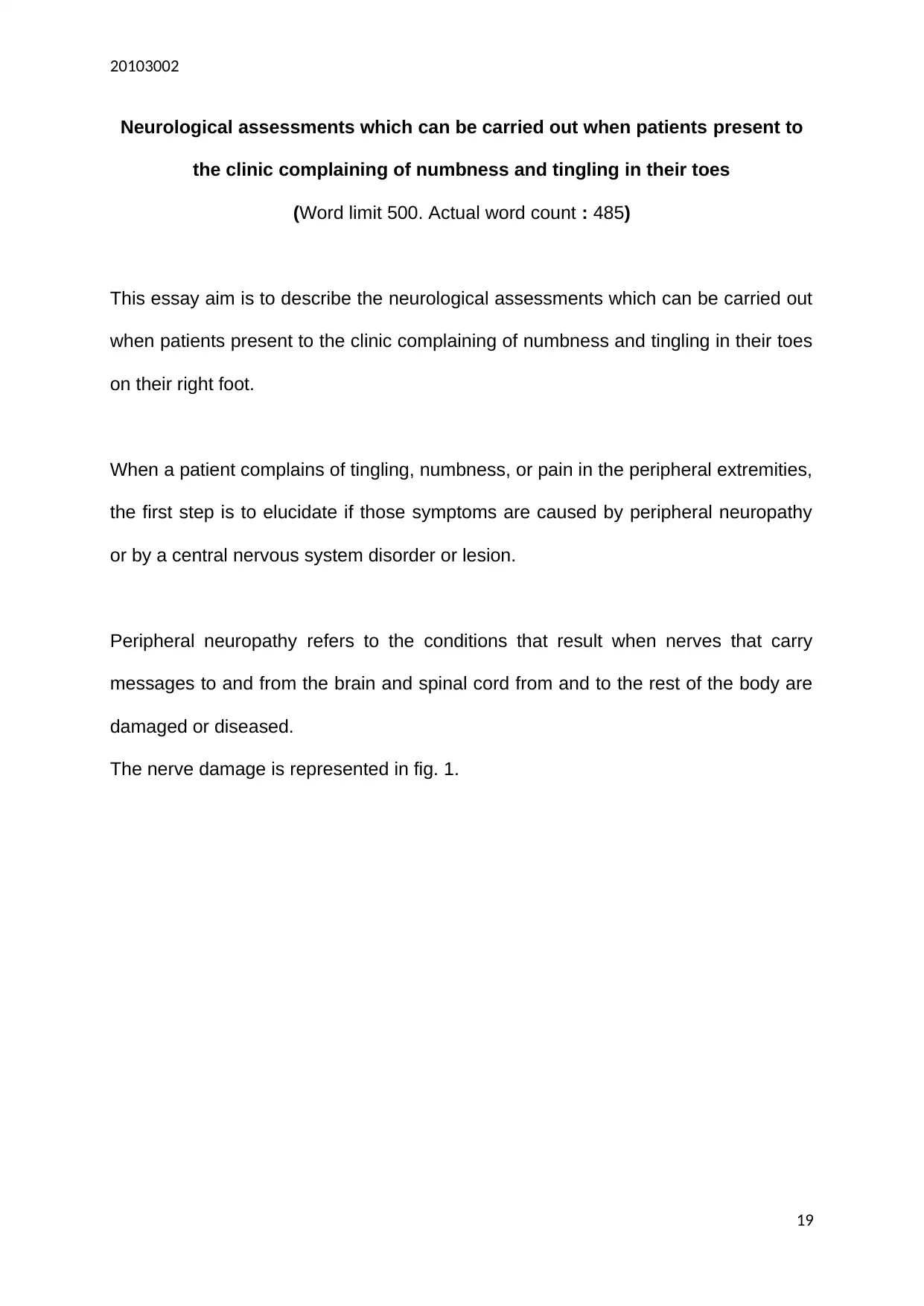
20103002
Neurological assessments which can be carried out when patients present to
the clinic complaining of numbness and tingling in their toes
(Word limit 500. Actual word count : 485)
This essay aim is to describe the neurological assessments which can be carried out
when patients present to the clinic complaining of numbness and tingling in their toes
on their right foot.
When a patient complains of tingling, numbness, or pain in the peripheral extremities,
the first step is to elucidate if those symptoms are caused by peripheral neuropathy
or by a central nervous system disorder or lesion.
Peripheral neuropathy refers to the conditions that result when nerves that carry
messages to and from the brain and spinal cord from and to the rest of the body are
damaged or diseased.
The nerve damage is represented in fig. 1.
19
Neurological assessments which can be carried out when patients present to
the clinic complaining of numbness and tingling in their toes
(Word limit 500. Actual word count : 485)
This essay aim is to describe the neurological assessments which can be carried out
when patients present to the clinic complaining of numbness and tingling in their toes
on their right foot.
When a patient complains of tingling, numbness, or pain in the peripheral extremities,
the first step is to elucidate if those symptoms are caused by peripheral neuropathy
or by a central nervous system disorder or lesion.
Peripheral neuropathy refers to the conditions that result when nerves that carry
messages to and from the brain and spinal cord from and to the rest of the body are
damaged or diseased.
The nerve damage is represented in fig. 1.
19
Paraphrase This Document
Need a fresh take? Get an instant paraphrase of this document with our AI Paraphraser

20103002
Fig. 1
The peripheral nervous system consists of sensory neurons, ganglia and nerves that
connect the central nervous system to arms, hands, legs and feet, as it is
represented in fig. 2.
20
Fig. 1
The peripheral nervous system consists of sensory neurons, ganglia and nerves that
connect the central nervous system to arms, hands, legs and feet, as it is
represented in fig. 2.
20
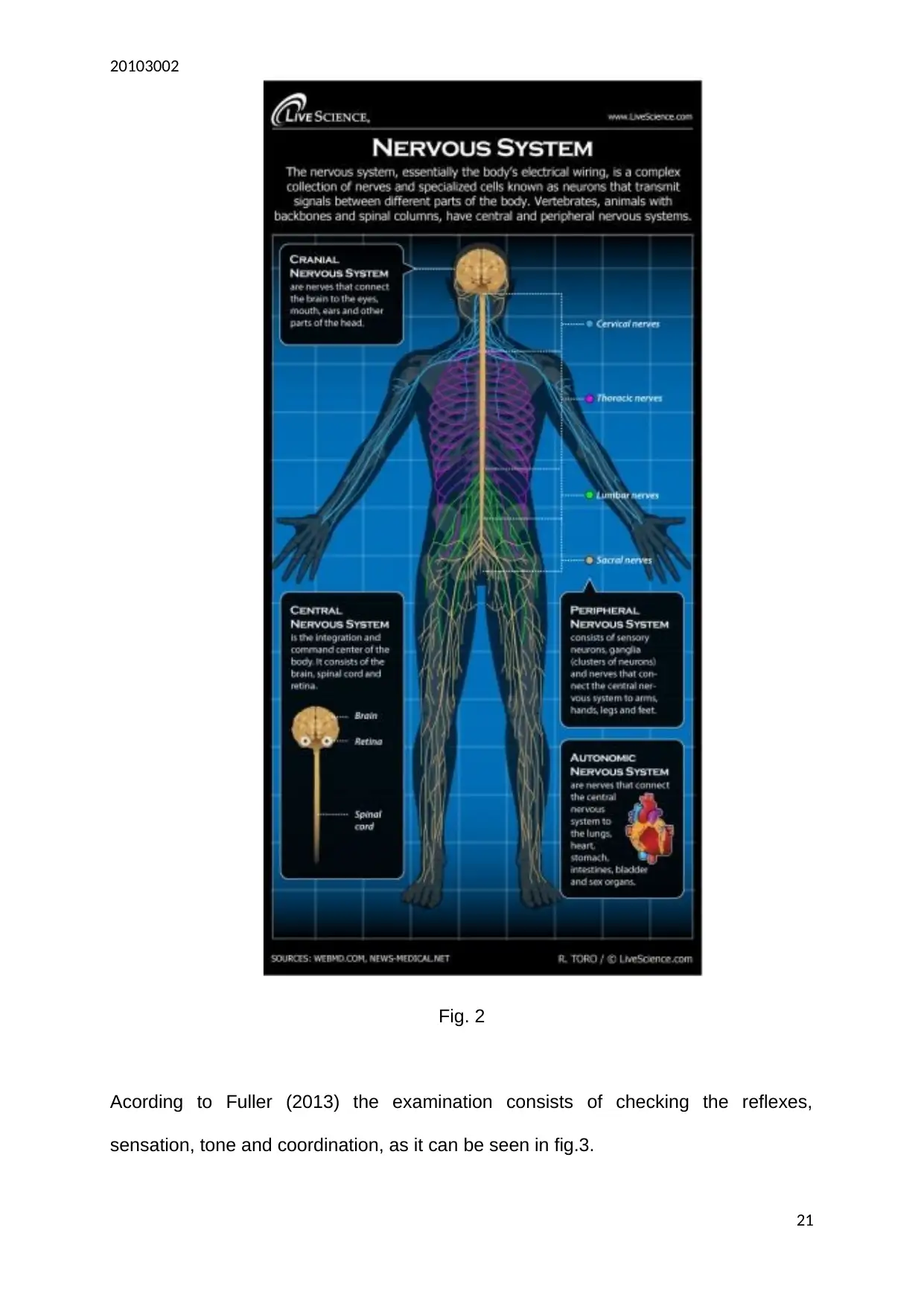
20103002
Fig. 2
Acording to Fuller (2013) the examination consists of checking the reflexes,
sensation, tone and coordination, as it can be seen in fig.3.
21
Fig. 2
Acording to Fuller (2013) the examination consists of checking the reflexes,
sensation, tone and coordination, as it can be seen in fig.3.
21
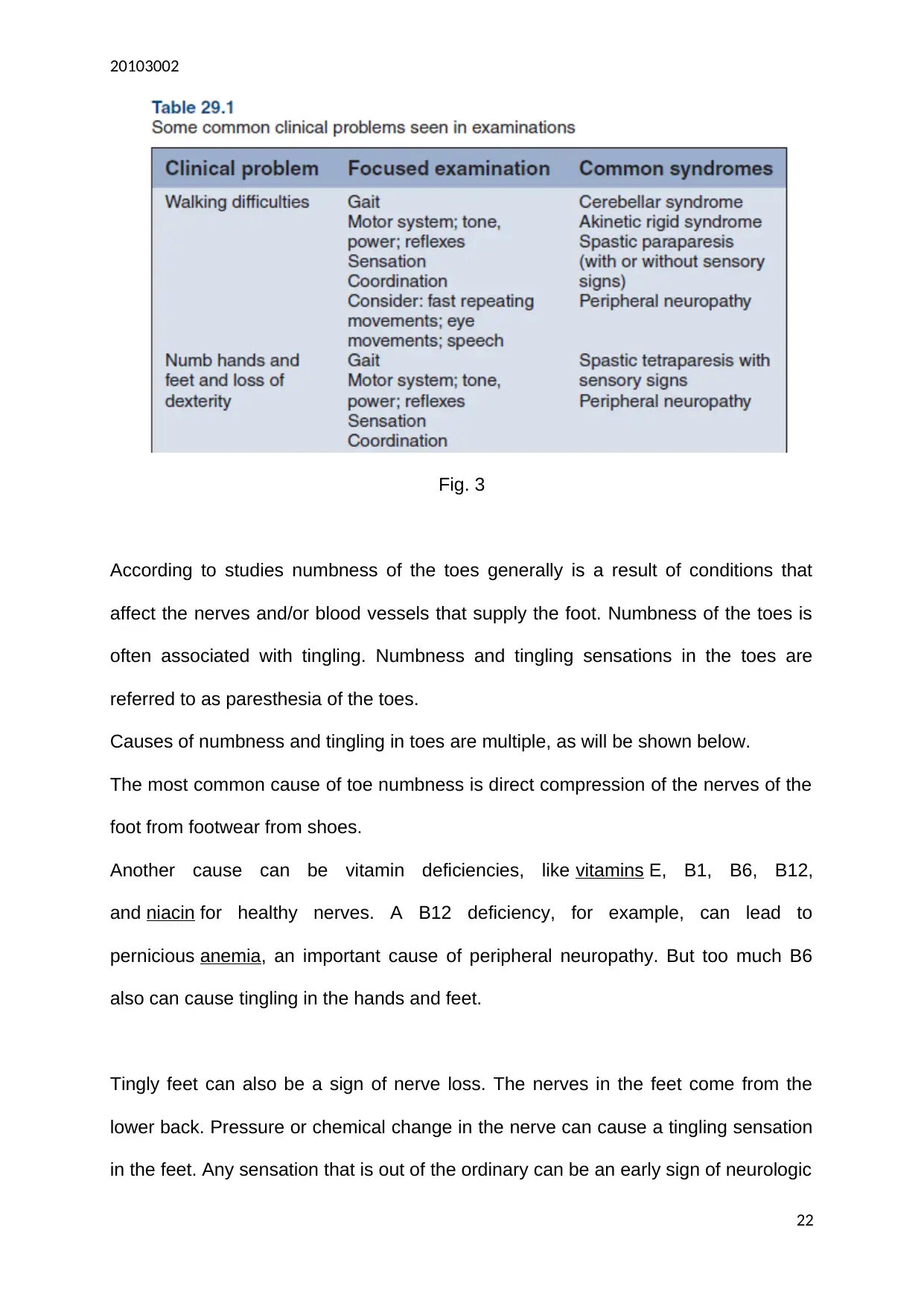
20103002
Fig. 3
According to studies numbness of the toes generally is a result of conditions that
affect the nerves and/or blood vessels that supply the foot. Numbness of the toes is
often associated with tingling. Numbness and tingling sensations in the toes are
referred to as paresthesia of the toes.
Causes of numbness and tingling in toes are multiple, as will be shown below.
The most common cause of toe numbness is direct compression of the nerves of the
foot from footwear from shoes.
Another cause can be vitamin deficiencies, like vitamins E, B1, B6, B12,
and niacin for healthy nerves. A B12 deficiency, for example, can lead to
pernicious anemia, an important cause of peripheral neuropathy. But too much B6
also can cause tingling in the hands and feet.
Tingly feet can also be a sign of nerve loss. The nerves in the feet come from the
lower back. Pressure or chemical change in the nerve can cause a tingling sensation
in the feet. Any sensation that is out of the ordinary can be an early sign of neurologic
22
Fig. 3
According to studies numbness of the toes generally is a result of conditions that
affect the nerves and/or blood vessels that supply the foot. Numbness of the toes is
often associated with tingling. Numbness and tingling sensations in the toes are
referred to as paresthesia of the toes.
Causes of numbness and tingling in toes are multiple, as will be shown below.
The most common cause of toe numbness is direct compression of the nerves of the
foot from footwear from shoes.
Another cause can be vitamin deficiencies, like vitamins E, B1, B6, B12,
and niacin for healthy nerves. A B12 deficiency, for example, can lead to
pernicious anemia, an important cause of peripheral neuropathy. But too much B6
also can cause tingling in the hands and feet.
Tingly feet can also be a sign of nerve loss. The nerves in the feet come from the
lower back. Pressure or chemical change in the nerve can cause a tingling sensation
in the feet. Any sensation that is out of the ordinary can be an early sign of neurologic
22
Secure Best Marks with AI Grader
Need help grading? Try our AI Grader for instant feedback on your assignments.
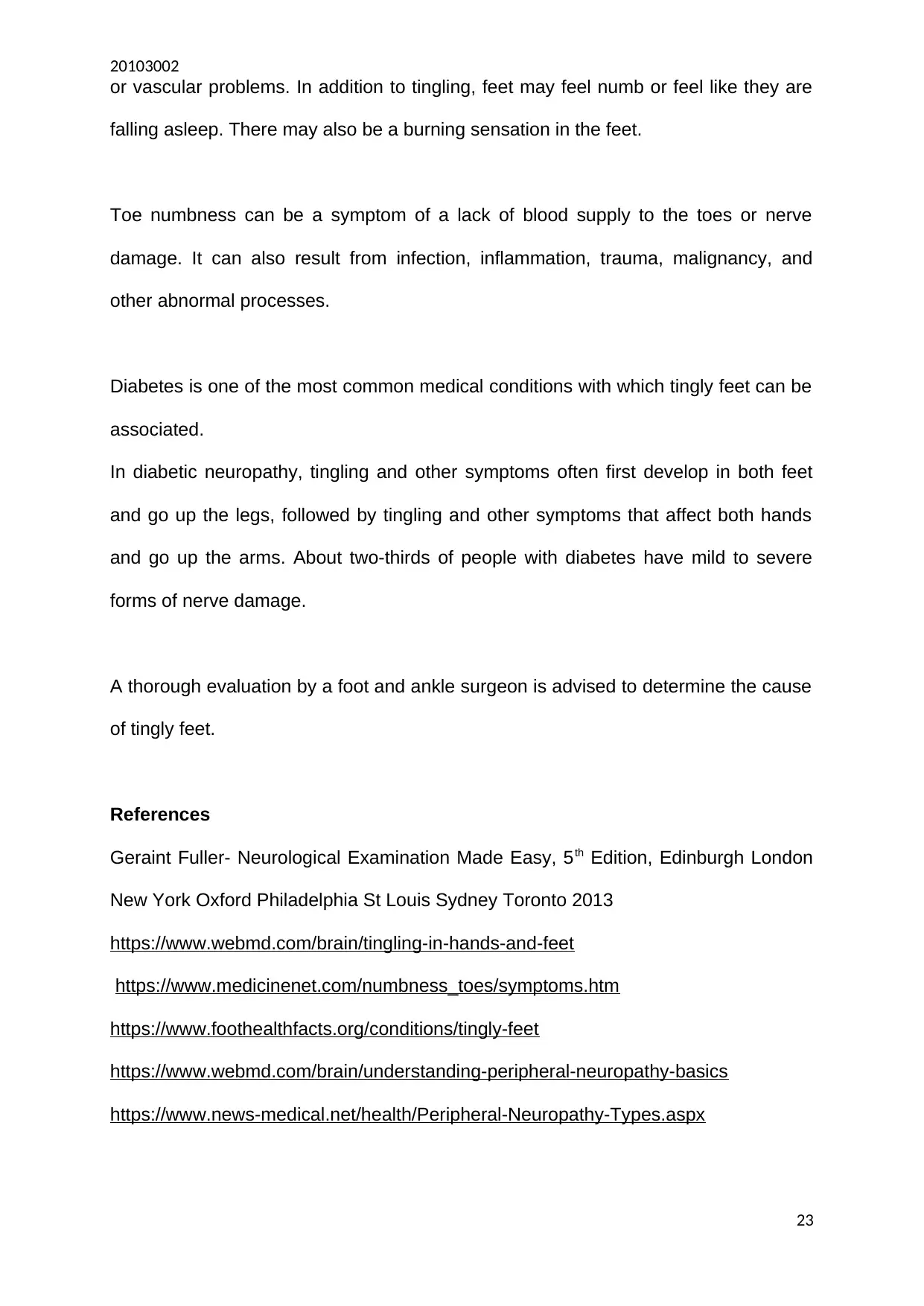
20103002
or vascular problems. In addition to tingling, feet may feel numb or feel like they are
falling asleep. There may also be a burning sensation in the feet.
Toe numbness can be a symptom of a lack of blood supply to the toes or nerve
damage. It can also result from infection, inflammation, trauma, malignancy, and
other abnormal processes.
Diabetes is one of the most common medical conditions with which tingly feet can be
associated.
In diabetic neuropathy, tingling and other symptoms often first develop in both feet
and go up the legs, followed by tingling and other symptoms that affect both hands
and go up the arms. About two-thirds of people with diabetes have mild to severe
forms of nerve damage.
A thorough evaluation by a foot and ankle surgeon is advised to determine the cause
of tingly feet.
References
Geraint Fuller- Neurological Examination Made Easy, 5th Edition, Edinburgh London
New York Oxford Philadelphia St Louis Sydney Toronto 2013
https://www.webmd.com/brain/tingling-in-hands-and-feet
https://www.medicinenet.com/numbness_toes/symptoms.htm
https://www.foothealthfacts.org/conditions/tingly-feet
https://www.webmd.com/brain/understanding-peripheral-neuropathy-basics
https://www.news-medical.net/health/Peripheral-Neuropathy-Types.aspx
23
or vascular problems. In addition to tingling, feet may feel numb or feel like they are
falling asleep. There may also be a burning sensation in the feet.
Toe numbness can be a symptom of a lack of blood supply to the toes or nerve
damage. It can also result from infection, inflammation, trauma, malignancy, and
other abnormal processes.
Diabetes is one of the most common medical conditions with which tingly feet can be
associated.
In diabetic neuropathy, tingling and other symptoms often first develop in both feet
and go up the legs, followed by tingling and other symptoms that affect both hands
and go up the arms. About two-thirds of people with diabetes have mild to severe
forms of nerve damage.
A thorough evaluation by a foot and ankle surgeon is advised to determine the cause
of tingly feet.
References
Geraint Fuller- Neurological Examination Made Easy, 5th Edition, Edinburgh London
New York Oxford Philadelphia St Louis Sydney Toronto 2013
https://www.webmd.com/brain/tingling-in-hands-and-feet
https://www.medicinenet.com/numbness_toes/symptoms.htm
https://www.foothealthfacts.org/conditions/tingly-feet
https://www.webmd.com/brain/understanding-peripheral-neuropathy-basics
https://www.news-medical.net/health/Peripheral-Neuropathy-Types.aspx
23

20103002
https://www.livescience.com/27975-human-body-system-the-nervous-system-
infographic.html
24
https://www.livescience.com/27975-human-body-system-the-nervous-system-
infographic.html
24
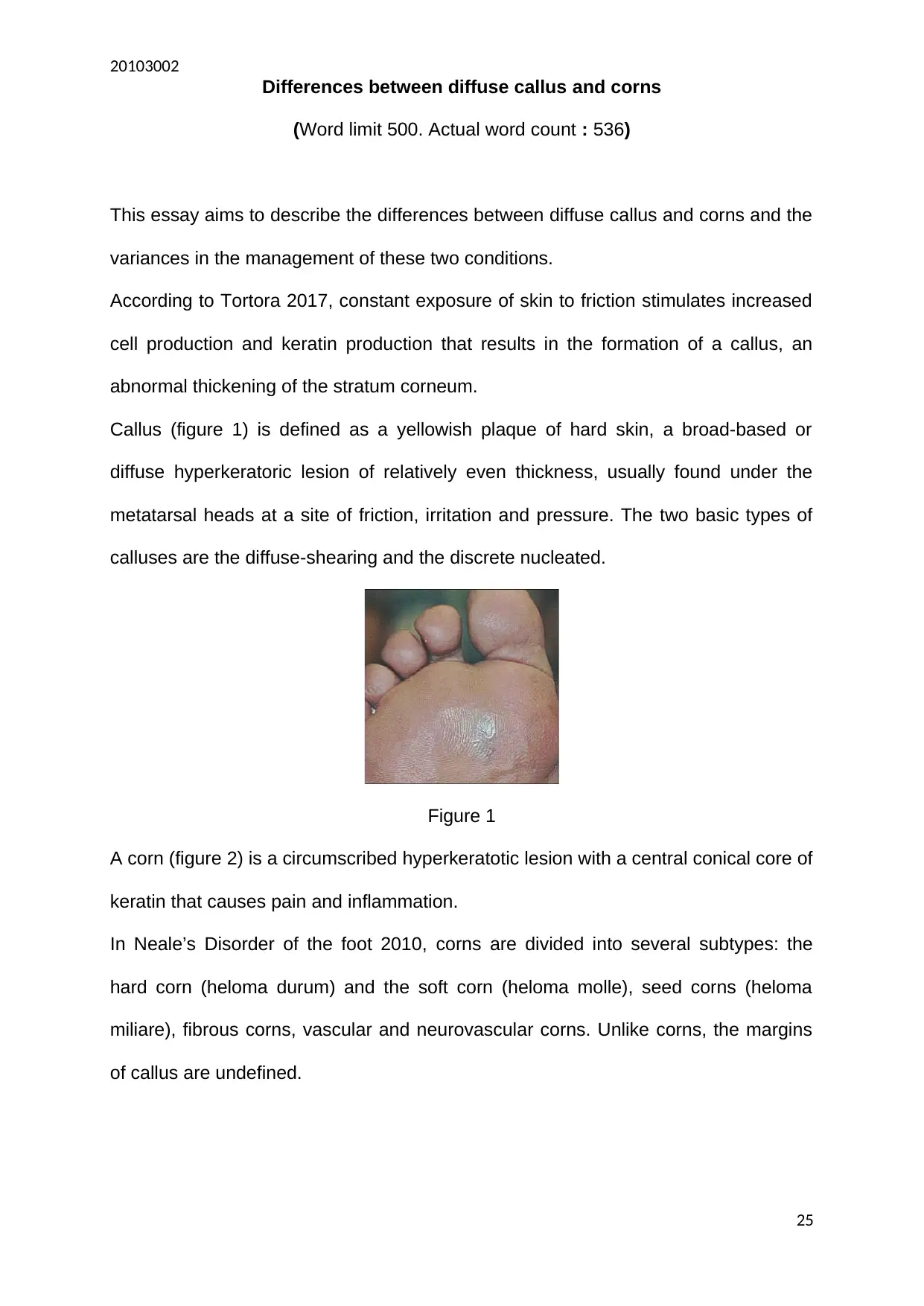
20103002
Differences between diffuse callus and corns
(Word limit 500. Actual word count : 536)
This essay aims to describe the differences between diffuse callus and corns and the
variances in the management of these two conditions.
According to Tortora 2017, constant exposure of skin to friction stimulates increased
cell production and keratin production that results in the formation of a callus, an
abnormal thickening of the stratum corneum.
Callus (figure 1) is defined as a yellowish plaque of hard skin, a broad-based or
diffuse hyperkeratoric lesion of relatively even thickness, usually found under the
metatarsal heads at a site of friction, irritation and pressure. The two basic types of
calluses are the diffuse-shearing and the discrete nucleated.
Figure 1
A corn (figure 2) is a circumscribed hyperkeratotic lesion with a central conical core of
keratin that causes pain and inflammation.
In Neale’s Disorder of the foot 2010, corns are divided into several subtypes: the
hard corn (heloma durum) and the soft corn (heloma molle), seed corns (heloma
miliare), fibrous corns, vascular and neurovascular corns. Unlike corns, the margins
of callus are undefined.
25
Differences between diffuse callus and corns
(Word limit 500. Actual word count : 536)
This essay aims to describe the differences between diffuse callus and corns and the
variances in the management of these two conditions.
According to Tortora 2017, constant exposure of skin to friction stimulates increased
cell production and keratin production that results in the formation of a callus, an
abnormal thickening of the stratum corneum.
Callus (figure 1) is defined as a yellowish plaque of hard skin, a broad-based or
diffuse hyperkeratoric lesion of relatively even thickness, usually found under the
metatarsal heads at a site of friction, irritation and pressure. The two basic types of
calluses are the diffuse-shearing and the discrete nucleated.
Figure 1
A corn (figure 2) is a circumscribed hyperkeratotic lesion with a central conical core of
keratin that causes pain and inflammation.
In Neale’s Disorder of the foot 2010, corns are divided into several subtypes: the
hard corn (heloma durum) and the soft corn (heloma molle), seed corns (heloma
miliare), fibrous corns, vascular and neurovascular corns. Unlike corns, the margins
of callus are undefined.
25
Paraphrase This Document
Need a fresh take? Get an instant paraphrase of this document with our AI Paraphraser
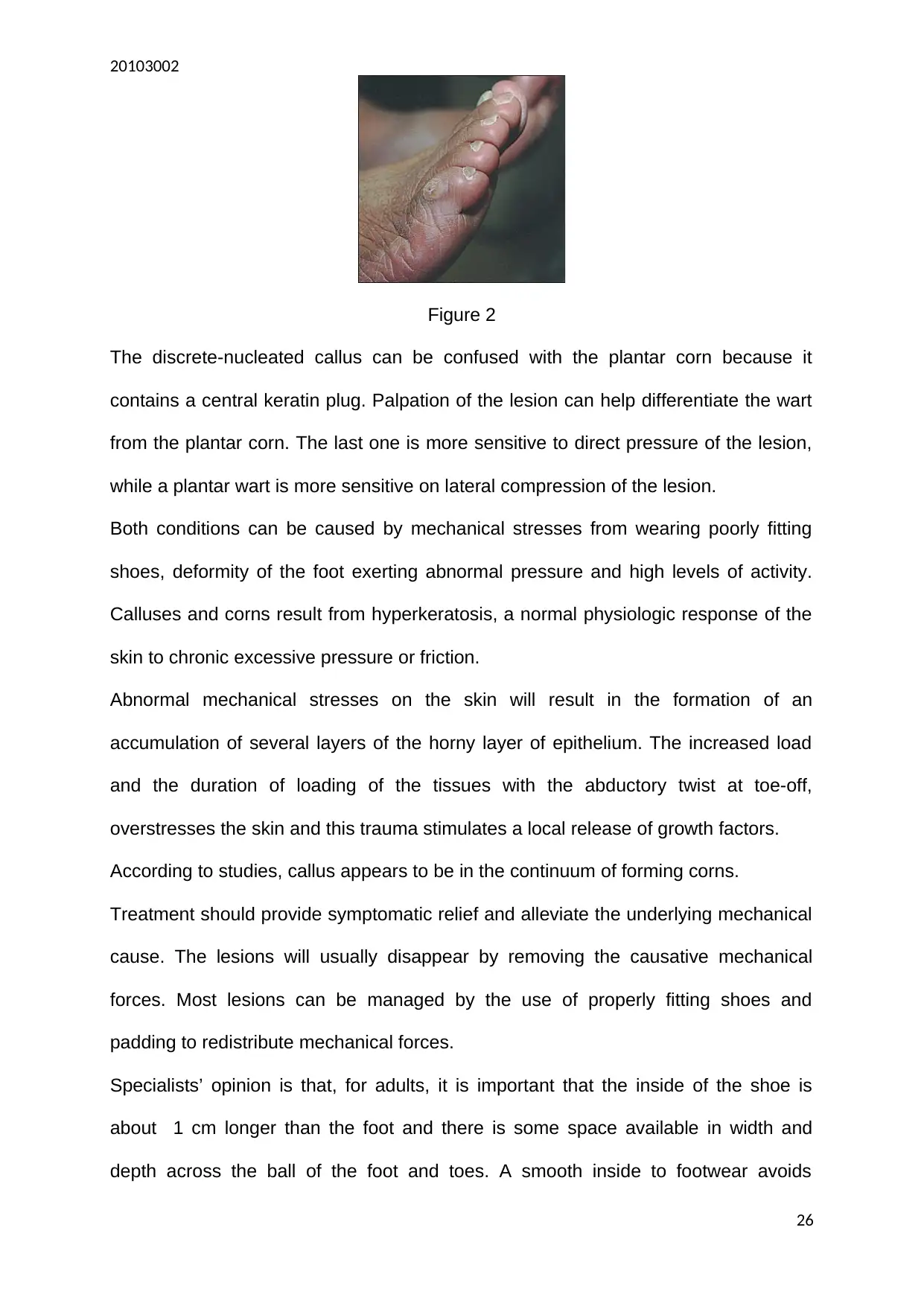
20103002
Figure 2
The discrete-nucleated callus can be confused with the plantar corn because it
contains a central keratin plug. Palpation of the lesion can help differentiate the wart
from the plantar corn. The last one is more sensitive to direct pressure of the lesion,
while a plantar wart is more sensitive on lateral compression of the lesion.
Both conditions can be caused by mechanical stresses from wearing poorly fitting
shoes, deformity of the foot exerting abnormal pressure and high levels of activity.
Calluses and corns result from hyperkeratosis, a normal physiologic response of the
skin to chronic excessive pressure or friction.
Abnormal mechanical stresses on the skin will result in the formation of an
accumulation of several layers of the horny layer of epithelium. The increased load
and the duration of loading of the tissues with the abductory twist at toe-off,
overstresses the skin and this trauma stimulates a local release of growth factors.
According to studies, callus appears to be in the continuum of forming corns.
Treatment should provide symptomatic relief and alleviate the underlying mechanical
cause. The lesions will usually disappear by removing the causative mechanical
forces. Most lesions can be managed by the use of properly fitting shoes and
padding to redistribute mechanical forces.
Specialists’ opinion is that, for adults, it is important that the inside of the shoe is
about 1 cm longer than the foot and there is some space available in width and
depth across the ball of the foot and toes. A smooth inside to footwear avoids
26
Figure 2
The discrete-nucleated callus can be confused with the plantar corn because it
contains a central keratin plug. Palpation of the lesion can help differentiate the wart
from the plantar corn. The last one is more sensitive to direct pressure of the lesion,
while a plantar wart is more sensitive on lateral compression of the lesion.
Both conditions can be caused by mechanical stresses from wearing poorly fitting
shoes, deformity of the foot exerting abnormal pressure and high levels of activity.
Calluses and corns result from hyperkeratosis, a normal physiologic response of the
skin to chronic excessive pressure or friction.
Abnormal mechanical stresses on the skin will result in the formation of an
accumulation of several layers of the horny layer of epithelium. The increased load
and the duration of loading of the tissues with the abductory twist at toe-off,
overstresses the skin and this trauma stimulates a local release of growth factors.
According to studies, callus appears to be in the continuum of forming corns.
Treatment should provide symptomatic relief and alleviate the underlying mechanical
cause. The lesions will usually disappear by removing the causative mechanical
forces. Most lesions can be managed by the use of properly fitting shoes and
padding to redistribute mechanical forces.
Specialists’ opinion is that, for adults, it is important that the inside of the shoe is
about 1 cm longer than the foot and there is some space available in width and
depth across the ball of the foot and toes. A smooth inside to footwear avoids
26

20103002
causing problems such as blisters in the short term and corns and callus in the long
term.
According to Paul Frowen 2010, podiatric symptomatic management involves calls
reduction and corn enucleation with a scalpel to reduce pain. Pads may also be used
to change foot function temporarily.
Topical preparations may be used as well to reduce callus and corn hardness,
providing there are no contraindications such as poor peripheral tissue status or a
medical disorder such as diabetes or rheumatoid arthritis.
If there is a biomechanical aetiology, this needs assessing and managing with
orthoses and exercises. Surgery is only indicated if conservative measures fail and
should be aimed at correcting the abnormal mechanical stresses.
References
Gerard J. Tortora, Bryan Derrickson: Principles of ANATOMY & PHYSIOLOGY, 15th
Edition, Wiley 2017
Paul Frowen & Maureen O'Donnell & J. Gordon Burrow & Donald L. Lorimer : Neale's
Disorders of the Foot, 8th Edition, Churchil Livingstone, 2010
https://www.aafp.org/afp/2002/0601/p2277.html#afp20020601p2277-b4
https://i.ytimg.com/vi/d7ETqm1_fJw/maxresdefault.jpg?
fbclid=IwAR3FlLqokDSoCgWiISv35QLt4im5F4ZOYN_--
1MS7cow_MJEgKBK7XywjZc
27
causing problems such as blisters in the short term and corns and callus in the long
term.
According to Paul Frowen 2010, podiatric symptomatic management involves calls
reduction and corn enucleation with a scalpel to reduce pain. Pads may also be used
to change foot function temporarily.
Topical preparations may be used as well to reduce callus and corn hardness,
providing there are no contraindications such as poor peripheral tissue status or a
medical disorder such as diabetes or rheumatoid arthritis.
If there is a biomechanical aetiology, this needs assessing and managing with
orthoses and exercises. Surgery is only indicated if conservative measures fail and
should be aimed at correcting the abnormal mechanical stresses.
References
Gerard J. Tortora, Bryan Derrickson: Principles of ANATOMY & PHYSIOLOGY, 15th
Edition, Wiley 2017
Paul Frowen & Maureen O'Donnell & J. Gordon Burrow & Donald L. Lorimer : Neale's
Disorders of the Foot, 8th Edition, Churchil Livingstone, 2010
https://www.aafp.org/afp/2002/0601/p2277.html#afp20020601p2277-b4
https://i.ytimg.com/vi/d7ETqm1_fJw/maxresdefault.jpg?
fbclid=IwAR3FlLqokDSoCgWiISv35QLt4im5F4ZOYN_--
1MS7cow_MJEgKBK7XywjZc
27
1 out of 27
Your All-in-One AI-Powered Toolkit for Academic Success.
+13062052269
info@desklib.com
Available 24*7 on WhatsApp / Email
![[object Object]](/_next/static/media/star-bottom.7253800d.svg)
Unlock your academic potential
© 2024 | Zucol Services PVT LTD | All rights reserved.
